Black Tie, White Lie

Running the Macau Marathon was perhaps my most realistic experience in this dreamy city of colossal architectures that truly come alive when the neon lights fill the night. Realistic because there's a 5-hour time limit to adhere to and a target of breaking my personal record. So, I had to be more focused in this race. As there were no pacers, I'd relied heavily on my watch to check my pace. Running in this foreign land added to the many unknowns in the race. What are the elevations like? Will it be too cold? How long and high is the Ponte de Sai Van? But I was excited and looked forward to this race, my 10th full marathon to date.
A light drizzle welcomed the runners, like an opening ceremony, as the pen opened. By 5 am, when the race started, it got heavier. Shoes were drenched, but the temperature was low. As crazy as it may sound, I rather enjoyed this unexpected running condition. There were 2 loops to be completed in this race, covering the Cotai Strip and central Macau Peninsula via Ponte de Sai Van. The first loop was mostly run in the rain, which meant lesser stops at the water points for me. Crossing the ponte for the first time, the view of the famous casinos and hotels shinning brightly in the dark was amazing. My pace was still within the sub-4 hour limit as I climbed to the highest point of the race - the top of Ponte de Sai Van. That was encouraging.
When I strategized for this race, despite the unknowns, I asked myself what contributed to my first sub-4 hour finish at this year's Standard Chartered KL Marathon, besides a controlled diet and sufficient sleep. The list included a few packs of power gel, MP3s during the second half of the race, and taking advantage of every descend by speeding down as fast as I could. I tried to reapply that so-called SCKLM formula in Macau.
The first loop ended with a sub 2-hour finish, so my confidence grew. By now, the city began to brighten up, but the clouds kept the sun in hide. Temperature was in the comfortable sub-tropical wintry range and it was still drizzling. To not lose my pace, I trailed behind a fellow runner of the similar speed until he sped towards the ponte. During the second loop, I was more aware of my surroundings. By now, I was able to identify some of the nearby Macau landmarks - Wynn, Mandarin Oriental, MGM and the stunning Grand Lisboa, as I ran along Avenidas Dr. Sun Yat Sen and Dr. Stanley Ho. Reaching Avenida Panoramica do Lago Sai Van signfied the completion of 35 kms. There were only 7 kms to go. Or so I thought. The fact is, the course was over-distanced by 2 kms. I mentally recalculated the time required to finish the now 44 km race within 4 hours and realised that it was still achievable if I maintained my current speed.
A marathon race with a completion time of below 5 hours is, in general, demanding. To me, Macau Marathon was more competitive than other races that I've participated in. I observed a higher average speed among runners here. It was inspiring but intimidating at the same time. But this was a race against my own personal record. Even I were the last to cross the finish line, I'd still be satisfied if my previous personal record was broken.
When I ran along the Avenida dos Jardins do Oceano again, I knew that I was approaching the finish line. The road from here to the Olympic Sport Centre Stadium was mostly flat, so that's a relief. Still clocking an average of 5 minutes per km, I just needed to maintain this pace and run steadily towards the finish line for my second sub-4 hour finish. But could I bet my personal best time at SCKLM?
At the last few hundred meters, I was greeting again by the large poster of Eason Chan's DUO concert, taking place a few weeks from now. Oh, I did mention that I'd run with MP3s again for this race? Yes, music did provide me with some distractions, and that's especially true when the playlist has been updated and randomized (for some suspense).
Runners had to make an almost complete loop on the stadium track before crossing the finish line. From far, I was able to see the electronic timer. Unless I collapse halfway along the track, I should be able to hit my second sub-4 hour marathon. And I did. I'd also broken my previous personal best by a good 6 minutes. Technically, it could have been better since the run was over-distanced. But that's okay. There's always another time for that.
I spent the next two days celebrating the end of another marathon in Macau with my family, visiting some of the most popular Macanese eateries in town. At Taipa Village, we tried O Santos and the limited pork chop burger (which we found later at the Venetian as well, despite the more expensive price tag). By the way, Lord Stow's Portuguese egg tarts can also be found at the Venetian! At central Macau Peninsula, we went to Tou Tou Koi at Travessa do Mastro for some old-school dim sum, savoured a few Portuguese egg tarts at Margaret's Cafe e Nata and my favourite, shrimp roe noodles, braised pork knuckle and poached carp skin from the legendary Cheong Kei along Rua da Felicidade. These eateries were conveniently located within walking distance from Senado Square, which also leads to the ruins of the church of St. Paul, the main tourist attaction in Macau. And what better way to cap the trip with, well, besides investing in a few rounds of Sic Bo, a spectacular show from The House of Dancing Water in the City of Dreams.
 Finishing the Macau Marathon with a new personal record was sweet. But more significantly, the race marked the completion of my 10th full marathon, a goal I'd set for myself in 2012. Throughout the year, I'd tried to train as consistently as I could (even if it involved sacrificing my social life) and read a few books on running to keep myself psyched up. In the process, besides improving my runs, I'd learned quite a bit about life. Running has made me more patient, tolerant and respectful of others. Physically, I'm fitter and although mortality is still out of my control, keeping up with a healthier lifestyle by eating well and working out regularly has led to less flu and common cold. What a good run, 2012!
Finishing the Macau Marathon with a new personal record was sweet. But more significantly, the race marked the completion of my 10th full marathon, a goal I'd set for myself in 2012. Throughout the year, I'd tried to train as consistently as I could (even if it involved sacrificing my social life) and read a few books on running to keep myself psyched up. In the process, besides improving my runs, I'd learned quite a bit about life. Running has made me more patient, tolerant and respectful of others. Physically, I'm fitter and although mortality is still out of my control, keeping up with a healthier lifestyle by eating well and working out regularly has led to less flu and common cold. What a good run, 2012!
I hope 2012 has been kind to you too. Here's wishing you a very happy and blessed 2013, my friend.










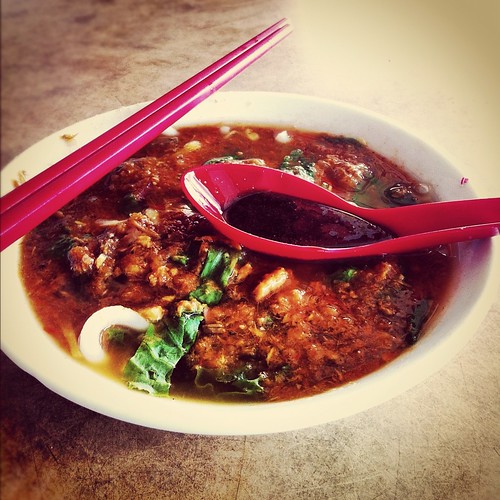
Unthinkable. That's how I'd describe my PBIM weekend in Penang. The journey from Singapore to Penang itself had been, while not torturous, very long. 10.5 hours by coach, to be exact. Fortunately for me, I was able to catch some sleep until Bagan Serai, the northern part of Perak. Reaching the Sungai Nibong Bus Terminal, after dropping off passengers at Butterworth and Bukit Mertajam, I made my way to the airport to collect my discounted (thanks to a voucher I picked during the Seremban Half Marathon) rental car. Since it was still early, I made a short stop at the snake temple near the airport, a place that I've not visited in decades. I asked the Gods for a safe run. Then, it was time for breakfast. With a GPS in hand, I headed for Balik Pulau in search of the infamous laksa. Just one sip of the sweet and sour broth was all it took to refresh my tired mind and body. After unpacking my bag at the hotel, I walked to Lorong Selamat and risked my life and order a plate of char kway teow from the lady seller wearing safety glasses. I'm happy to report that I was unharmed and the plate of char kway teow, though not my favourite, was really aromatic. Next up, carbo-loading. The nearest and most suitable place for that was Nasi Kandar Kasim along Jalan Gurdwara. Ideally, after a tambah nasi and telui (that's how the northern folks pronounce telur, I think) meal, I should be able to fall asleep rather quickly, but instead, I just rolled in bed, waiting for the hours to pass before the start of the marathon at 2 am.
The first kilometer along Queensbay Mall was difficult to run, as the road was narrow, but after making a turn at the roundabout heading for Eastin Hotel and the Seagate plant, runners began to spread out on the much wider highway. Running in the dark, odd hours in the morning wasn't enjoyable, but that's part of a marathon challenge. No excuses! Just like any 42.195 km race that I've entered, the first 10 kms are more physical - getting the muscles warmed up and keeping a 55-minute lap to ensure a sub-4 hour finish. Here, I exceeded the 55 minutes target slightly and so, I had to run faster at the Penang bridge. That didn't materialise. The 13 kms (one way) bridge has a few taxing inclines, and the toughest climb has to be to the peak of the cabled twin decks. Now, imagine doing that twice. The unpleasant combined smell of chemical emissions from the nearby factories and the sea hit at the start of the bridge route, but reduced gradually towards the main deck. The supply of water by the bottle was rather interesting. It might be a burden for some, but I thought it came in handy, where the excess water can be used to cool off the steaming head on that warm morning. I'd read about some leaving the unfinished bottle on the bridge for other fellow runners. Despite the straight and long (and therefore, boring) route, I felt good and proud running on this iconic Malaysian landmark, which is also the third longest bridge in the world. Looping at the toll plaza marked the completion of the first 21 kms. Next, we ran another 13 kms on the bridge before turning into Georgetown. The final leg, after returning from Georgetown towards Queensbay Mall, was difficult. I didn't hit the wall. And there was no sign of runner's diarrhoea! But my left shoulder started to sore badly and a side stitch bugged me for quite a distance. Also, the elevations were quite erratic. By the 38th km, I was almost certain that I would miss the sub-4 hour finish, but I pushed on. In the last 2 kms, I was joined by runners from the half marathon category as well. It was very congested and I zig-zagged my way through the crowd. I gave my friends who cheered me on at the finish line a thumbs-down, knowing that I'd missed the sub-4 hour finish by a wide 10 minutes.
I didn't feel terrible about my timing though. A little disappointed, yes. I wasn't prepared for a fast, record-breaking finish, having returned from South America just days before the race. A small part of me was also reserving the final push for the next marathon race, which would take place two weeks later.
By 9 am, I'd returned to the hotel. After a shower, I walked to Penang Road to reward myself with a bowl of laksa (of course) and some cendol. It's understandable why these hawkers have been doing brisk business for years now. Absolutely delicious. I checked out at noon and headed to my favourite mee goreng stall at Bangkok Lane. It was as moist, flavourful and red as I'd remembered. To ease digestion before the next round of hawker food, I drove to Armenian Street to see some of Ernest Zacharevic's wall paintings. They were certainly charming. Souvenirs imprinted with these paintings were on sale along the street, which I thought was cool. Then, it was time for more food...well, laksa, I mean. I guess by now, you'd already known my favourite Penang food? My first stop was Kafe Mega Star along Jalan C.Y. Choy. This is not a tourist haunt, which makes it even more attractive to me. The elderly cooks and heavy porcelain bowls were instinctively convincing. I'm not sure what constitutes an authentic bowl of Penang laksa, but if it comes with a sweet, sour but not spicy broth topped with pieces of mackerel and a colourful array of shredded lettuce, onion, cucumber, and pineapple, then it works for me. And I found it here at Mega Star. Next, I drove to Ayer Itam Market, below the Kek Lok Si temple, for a bowl of laksa from the perpetually crowded stall. Thank goodness they allowed customers to eat at the food market across the road, else I'd have to wait for hours to get a chair. The broth here was darker and denser, as compared to the rest that I've tried in the past 48 hours. And definitely good enough to be ranked among the best that I've tried in Penang thus far. I wanted to visit Kek Lok Si but there wasn't much time, since I had some unfinished business to settle back in Georgetown, which was....bagging boxes of tau sar piah from Ghee Hiang, at the only outlet that still had stock for the day! Before leaving for the airport, I made one last convenient stop at New Lane for some curry mee and char kway teow, which were less stellar and more expensive.
Sitting in the plane, I began to recall my time and tummy packed weekend in Penang. And that's when Unthinkable came to mind. My finish time at the PBIM 2012 was not regrettable. In fact, I should thank PBIM 2012 for giving me a chance to rekindle with this tantalizing island, our pearl of the orient that Tan Twan Eng described so beautifully in The Gift Of Rain. And how appropriate and lucky of me to end my trip to this hawker food paradise being seated next to an international streetfood blogger couple in the plane. Hor liao, eh?
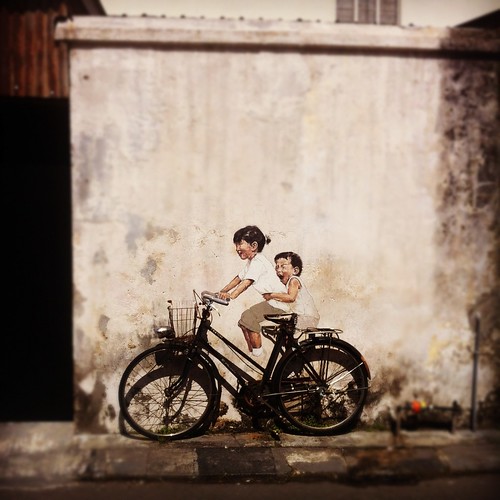











I started trail running in August and enjoyed it very much because the terrain is mostly softer (and therefore does less damage to the knees) and the air is fresher in the reserves. It is also excitingly unpredictable. The route may stay constant but the obstacles along the course that nature has designed for me changes with every run. Every move is strategized so that I don't trip over fallen trees or rocks. The first few runs were the worst as I was unable to control my pace and ended up spraining my ankles. After a rain, the ground is muddy, causing the legs to be significantly heavier. Fallen trees are to be climbed over with care while landing on dead leaves should be avoided, for I don't know what's underneath the pile. On clear days, insects come out to play. Oh, and encounters with leeches are common, I was told.
Trail runs expose oneself to the wild. It's adventurous and intimidating at the same time. When I told my parents that I started running in FRIM (Forest Research Institute of Malaysia), they were horrified. Having spent their childhood in that neighbourhood, they'd heard countless stories of roaming tigers and pythons in the forest reserve. As much as I tried to ignore their reminders to stay away from the quieter trails, there's always a part of me that was afraid and hoped that I would not come face to face with a tiger or wildboar. Running alone in the early hours on these quieter trails can be nerve-wrecking. To be brave is to continue running. I was forced to be more aware of my surroundings and muttered a little prayer when I felt unsafe. I'm not quite a religious person but having that bit of faith that I'll be safe and protected was calming.
Stories of tigers, pythons and bears aside, FRIM is an excellent place to run. There are many trails in FRIM, including one that leads to a new village in Sungai Buloh (where I got lost once). After studying the reserve's map, I'd customized a route for myself; a 17-kilometer course that covers the ethereal Dream Trail, Bukit Bujang, Rover Track, Pipeline Track, Mountain Bike Track, Tongkat Ali Trail and Steroid Hill. These days, when I run a challenging race course, I remind myself that nothing comes close to being as dififcult as running continuously to the top of FRIM's Steroid Hill. At an elevation of 300 meters to Steroid Hill's Pinus Peak, I almost blacked out in my first attempt. Having run the course 8 times now, I must say that my lungs capacity has increased.
Why did I start trail running? To cut the long story short, I was training for my first ultra trail marathon - The NorthFace 100 Singapore in October. While runners debate on the definition of an ultramarathon, I will take it that an ultra is any distance beyond 42.195 km (the full marathon distance). So, yes, 50 km is an ultramarathon to me. Hah!
TNF100 took place on 13 October 2012. It was a Saturday, which means I had only a few hours of rest between knocking off work on Friday evening and the race. Fortunately, anxiety didn't follow me to bed (I wasn't targetting a personal best this time, just hoped to complete the race within the stipulated time limit), and I was able to fall asleep rather quickly.
The race was divided into 6 sections. The first, Lornie Track and the MacRitchie Reservoir Nature Trail, was the most pleasant to run and reminded me very much of FRIM. I was overtaken by many runners but it wasn't a bit demoralising. The journey ahead was long and for a beginner like myself, it's better to take it slow, enjoy the experience and finish in one, healthy piece. The second section ran along Rifle Range Road and Golf Link. Here's where we exited MacRitchie and entered another indistinguishable nature reserve. At this early stage of the race, I tried not to observe the distance covered. Instead, I focused on my footwork.
My hydration bag was still full. The plan was to drink a few cups of isotonic drink at each water point and save the 1.5-liter in the bag for later. Although it was marked clearly in the course map the locations of the water points, which were at least 5 kilometers apart, memory of the locations of these points was lost together with the buckets of sweat as I ran. The humidity of the nature reserves contributed to more fluid loss. I hoped that the sky would be kind enough to offer us a generous supply of clouds as the day progressed.
I am referring to the TNF100 map as I draft this post. Without it, I'll not be able to recall the names of the race sections. I guess that's understandable. In a long distance run like this, numbers, in forms of time and distance, are more important than the trails' names. But anyway, we entered the third section of the race - the Durian Loop and Pandan Trail. Here's where we headed north, crossing the Bukit Timah Expressway and ran along the old KTM railway track. The track was narrow but by now, runners were already spread far apart from one another, so congestion and overtaking weren't our major concerns. The sun was rising when I reached the track. It is going to be a clear day, I assured myself. I adjusted my visor and continued running.
At that time of my so-called running life, I was experimenting with the influence of music on my pace. You see, loud music sinks the sounds of my heavy breathing, which leads my brains to think that I'm still doing okay. So, I can running longer at that particular pace. On the other hand, different beats can also cause the running pace to fluctuate. As much as I'd like to have System Of A Down throughout the run, my heart would not be able to withstand it. So, some Katy Perry (except Hot N Cold, of course) to bring the pace down a notch for balance is advisable. Knowing TNF100 would be the most challenging race yet, I'd decided to not hear my sufferings but instead of packing in my faithful, salinated MP3 player, I chose to be enthralled by the sounds of nature. But who was I kidding, right? I was running in Singapore. The noise along the nearby expressway can easily mute the few birds chirping in the reserve. Oh well...
Section 4 includes running around the Dairy Farm Park before continuing along Bukit Timah Expressway again, to ZhenHua Park. Dehydration and tiredness had set in. Rather alarming, I must say, as I was still far from the halfway mark. Trail running is really more consuming. Thankfully, the sky was still cloudy. Next, we ran into Gangsa Track of Section 5, which felt like the longest trail ever due to its mundanity. Here, runners and weekend cyclists made way for one another along this narrow trail. I was desperate to get out of here and complete the first 25 kilometers of the race.
One of the interesting parts of participating in a race, regardless of its distance, is observing my fellow runners, especially those of a similar pace. In TNF100, I paced behind a determined girl, who was accompanied by her heavy-built boyfriend. He provided her with countless encouraging words until he ran out of breath and stopped to rest while his girlfriend spurred on. And he would catch up later and restart his mantra. I also bumped into a familiar runner from Malaysia who looked like a colleague of mine. I'd named him bouncy because he could lift his legs off the ground so effortlessly. And man, he's fast! I don't know if anyone would observe or remember me as I run, but if they do, I hope it's not that pale-faced, hairy, struggling dude.
I had been anticipating Section 6, the Central Catchment PCN and Lorong Asrama, ever since I received the race map. Here's where the halfway mark was placed and where we had to climb Hill 265. Running up this hill was unthinkable. It was like Steroid Hill on steroid. I'm not joking. Given its slippery surface, I had to climb on all four limbs to prevent falling off this monstrous obstacle that the organizers had included. Upon reaching the top, and after gulping a few cups of isotonic drink later, it was time to make a turn and start the second half of the race.
By now, I'd lost sight of the determined girl (and her boyfriend). In fact, I was running alone along Lorong Asrama. Here, on this unfamiliar tarmac road, decorated with tall, lush trees, I reduced my pace and smilingly absorbed this moment of solitude that is quite precious in Singapore.
Before returning to the narrow Gangsa Track, I'd chewed a bag of GU Chomps that tasted like condensed jelly. And it had to be done when nearing the water points because they stuck easily to the teeth and some water was needed to wash them off. Reloaded, I entered the shady track again. Along the way, I met many real ultramarathoners (those doing the 100 km trail race) proceeding with their second loop. The faces showed that they were worn out, having run more than 65 kilometers since Friday night. I have utmost respect for this league of runners. And they'd motivated me to keep running.
How long more to go, bro?, asked a cyclist as we crossed paths along Gangsa Track. 15 kilometers, I replied. You're very near!, he said. His words were uplifting and I carried them with me at every incline, but in the end, they faded with my deteriorating stamina. Completing that 15 kilometers on trail is not as easy as running the last 15 kilometers of a city marathon. The paths are narrower with more undulations and the terrains can and will vary. A quick check on my pace showed that I was well within the race time limit, so I decided walk, up the inclines, for the first time in a race. Every step was mentally a pain because as much as I'd wanted to run, the body just wouldn't cooperate. So, I walked on and ran on every descend.
Exiting Gangsa Trail, I was now running in the less tiring Bukit Timah Nature Reserve of Section 4. With the roads now wider and flatter, my pace was also steadier. I caught up with bouncy again. That didn't last long though. It started with flatulence, which is always an indication that I'll soon be hit by runner's diarrhoea. Mobile toilets are placed far apart, so I decided to go for a toilet break at the next available booth to unload. If I am to compile a list of most frequently used words in a running post, diarrhoea is definitely up there, with toilet and bowels. Funny and embarassing, I know.
The sky turned grey as I entered Rifle Range Link. The wind was blowing strong and rain would fall eventually. I tried to run fast but the legs were getting heavier with every step. Earlier, my toes had hit a huge tree's roots and the pain didn't make the run any easier. With just a few kilometers away from the finish line, I just kept running, disregarding the snail pace that I was maintaining. Returning to Section 1, Lornie Trail, I overheard a runner informing his partner that the finish line was just 2 kilometers away. That perked me up. The blaring of music was also getting louder as I ran, so the finish line must be really, really close now.
Exiting the shades was such a relief. With the finish line in sight now, I removed my visor and was ready to pose for the camera. When I finally stopped running for the day, I wasn't thinking about the finisher's medal or how proud I felt completing my first ultramarathon. Instead, I recalled the trainining sessions in FRIM and how far I'd come since my starting my preparation after the River Jungle Marathon. And that made me really, really happy. There was a good buffet spread offered to all finishers but I just packed some home for later. Meeting an ex-colleague at the buffet table was a bonus and we spent some time catching up before promising to meet at another marathon.
The trails have given me a deeper appreciation towards running. I understand better the importance of good footwork, gait and breathing technique. I can tackle the hills more effectively by, as Martin Dugard described so appropriately in To Be A Runner, forcing me to lean into it, keeping my arms low to stay relaxed and my chin tilted up to increase oxygen flow. In short, trails made me a better runner. I don't know if I'll ever attempt a competitive trail run or an ultramarathon again but I will definitely revisit FRIM, for there are more trails to discover and I bet they are all exciting and fun.











Breaking dawn at Semenyih Dam Reservoir
The run was to start in a few minutes. Chatting with some new friends did calm the nerves a little, but nothing could hide the fact that I came unprepared. I was, at the same time, thankful that I made it to this run, having just returned from China for work. Throughout the trip, I was insistent that I wouldn’t extend my stay there and miss the run. You may say that I was being unprofessional. Well, in the end, the job got done and there I was, standing at SJK (C) Choon Hwa with my hydration bag strapped to my back, ready to experience this boutique marathon run that promised a scenic route around the town of Hulu Langat. The hydration bag wasn’t meant for the River Jungle Marathon but I thought it would be a good study of how my shoulders would react to having constantly loaded with 1.5 liters of water, plus a few energy bars. This exercise was part of the preparation for my next run – the North Face 100 Singapore, a self-sufficient 50 km trail run.
There were no rankings or prizes for this run. Runners were just advised to complete the run within a certain timeframe. So I started slow, keeping a constant pace that didn’t leave me begging for air. Despite the name of the run, runners were running on tarmac, along highways and narrow kampung roads. The highlight of this run was definitely the 300 meters ascend to the peak of Bukit Hantu (Ghost Hill) at the 17th kilometer, spanning 3 km, which a friend described as running up Genting Highlands. And it was really as difficult a climb as she had described.
I began the climb just as the day brightened. Given the altitude and forestry, the roads were cooling and mostly misty. Running through the mist was such a liberating experience that I couldn’t help spread my arms wide as I ran. Runners started walking instead of speeding to the peak. I decided to keep running despite my much slower pace. With every step, I reminded myself not to walk. If I can’t endure this, I will not survive the North Face challenge, I told myself.
Isn’t the view amazing?, asked a fellow runner when I overtook her during the tough climb. Go! Go! It’s just another 1 kilometer to the top!, she added. She must have been a regular RJM participant. That’s one of the countless good memories I had from participating in the RJM. A non-competitive marathon, this is a run for those who really appreciate the joys of long distance running. The organizers did an excellent job in making sure that runners have a good time by providing a beautiful route (especially along the Semenyih Dam Reservoir), sufficient water points, supportive volunteers (one even helped to splash iced water on my head!) and at the 37th kilometer, the mother of all surprises – chilled coconut water! As the sun burnt and tiredness grew, every gulp of the coconut water was blissful.
Rehydrated (but slightly brain-frozen), I pushed on. The final few kilometers, passing through the kampungs, were disastrous. Runner’s diarrhoea had hit again. I’d feared but somehow expected this, given the lack of training during my business trip, causing the bowels to be reactivated during this longer distance run. I wished for some distractions but the roads were just too plain and quiet in the morning. There were times when I was tempted to unload behind the bushes.
The final kilometer was the worst. I was on the verge of, well, explosion. Still, I decided not to walk, but stood still for a good minute, clenching my cold fists while watching a few runners passed me by. I took a few deep breaths and waited for the bowels to relax before starting to run again. Turning to the main road and passing by a morning market, the finish point was now in sight. The bowels started to misbehave again, but this time, instead of stopping, I ran faster and even managed to flash a smile for the camera. Receiving my finisher’s medal and T-shirt, I dashed into the mobile toilet.
Given my lack of training, the undulating terrains, diarrhoea and the dreadful Bukit Hantu climb, I managed to finish my run within the targeted timing. However, at the end of this run, I was still unsure if I was ready for TNF100. But running is an honest sport. To improve is to increase one’s mileage, be it on the road or trail. Instead of getting worried, I knew I had to run longer trails and intensify my core muscles training, in hope that by 13 October, I’d be ready for TNF100 Singapore – my first 50 km run, or what some termed – ultramarathon.










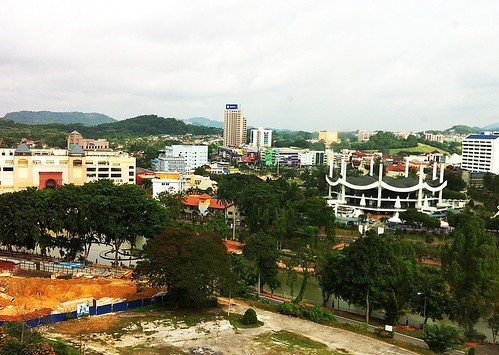
There was one more race to go before taking a break in August (the fasting month), when not a major race would be held...except in Singapore. Runners were spoilt for choice in selecting their pre-fasting/resting run in July – the Ipoh International , Feel Good, Men’s Health and Orange runs. And many more across the causeway.
I chose to run the Seremban Half Marathon in July because this is a race that I’ve known for a very long time. Since I started reading the Star, I think. That must have been more than 2 decades ago. Of course, in those inactive years, I’d not shown any interest or perhaps, hadn’t plucked enough courage to sign up for this, or any other run. The SHM was not a redemption run, but it sure felt good standing at the start line that morning on 15 July, albeit 20 years too late.
Running a half (that’s 21 km) after a series of full marathons was comforting, but I had no less respect for the distance this race carried. Training continued right after the Kuala Lumpur Marathon 2012, but I’d decreased my mileage by 30% to suit the race. The body needed some serious recovery as well. I certainly didn’t want to risk busting another ITB or knee.
Besides the run, I thought it would also be fun to rediscover Seremban’s famous eats while I’m in town. That’d make a nice post-race treat too. Honestly, I was more excited studying the route to the Pasar Besar Seremban (for the infamous beef noodles and Hakka mee) than the race course.
The scattering of July runs saw a smaller turnout, especially in the half-marathon category, I overheard while waiting for the Yang Amat Mulia Tunku Naquiyuddin to flag us off. But it was this intimate scale, coupled with the rare pleasure of roaming the quiet town at the break of dawn, that appealed to me. I was looking forward to a fun and fast (I promised to try) race.
There was no special preparation for this race. All I’d planned for was a good pre-race dinner of rice with a few light dishes. I had that at Restoran TC Keong. Serving some good old Chinese stir-fries (loved the steamed pork ribs with dace) in a neighbourhood away from town, I think we’ve found a restaurant locals throng. For supper, I had half a waffle with butter and syrup from the drive-through A&W (a Seremban landmark), and saved the other half for breakfast on race day.
Except for the unending, intermediate climbs around Forest Heights and passing by an old coffee shop named See Fatt, I have not much recollection of the race. I just ran, happy. At some points, especially after the 10th km, I glided at a new fast speed. I was definitely having a good time; the endorphin was at work. It was only during the final few kilometers, when we merged with the massive waves of walking schoolchildren, where we slowed a little to zigzag through this obstacle, that the calves began to pain.
As I entered the final kilometer of this race, a few thoughts ran through my mind; of completing the last race of the season in one piece, how I would spend my resting month, the anticipation of holding the limited edition of finisher’s medal from Royal Selangor Pewter, the gruesome races in the second half of the year and, of course, the awaiting delicious Seremban food. Soon, the sun was up in full force, blessing us with a Vitamin D shower. I was lucky to have crossed the finish line, celebrating a new sub 2-hour personal record, before it started to burn.
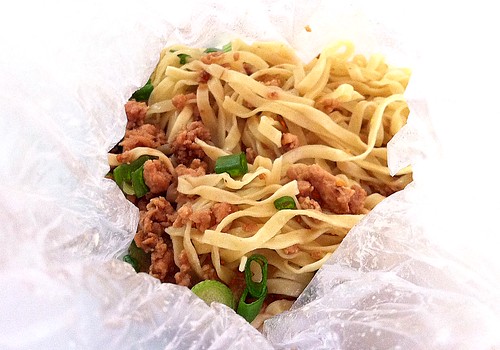 Soon after the race, the Pasar Besar Seremban foodcourt was filled with runners, most of them wearing finishers’ tees, especially the 2012 edition of the KL marathon. This busy pasar was quite the obvious choice for runners to refuel after their run because here’s where some of the most famous Seremban hawker stalls are located. While waiting for the legendary beef noodles to be served, I had, firstly, a plate of cuttlefish beehoon that came piping hot and full of wok hei. It was very satisfying. Next, still waiting for the beef noodles, I had Tow Kee’s Hakka mee, which despite its visual modesty, was a toss of well-proportioned egg noodles, minced pork and lard that resulted in a wonderful taste that I believe, can only be achieved through years of experience. The beef noodles finally came...30 minutes later. The gravy wasn’t as sweet and sticky as I’d remembered almost a decade ago. Bordering starchy and almost bland, it was a rather letdown.
Soon after the race, the Pasar Besar Seremban foodcourt was filled with runners, most of them wearing finishers’ tees, especially the 2012 edition of the KL marathon. This busy pasar was quite the obvious choice for runners to refuel after their run because here’s where some of the most famous Seremban hawker stalls are located. While waiting for the legendary beef noodles to be served, I had, firstly, a plate of cuttlefish beehoon that came piping hot and full of wok hei. It was very satisfying. Next, still waiting for the beef noodles, I had Tow Kee’s Hakka mee, which despite its visual modesty, was a toss of well-proportioned egg noodles, minced pork and lard that resulted in a wonderful taste that I believe, can only be achieved through years of experience. The beef noodles finally came...30 minutes later. The gravy wasn’t as sweet and sticky as I’d remembered almost a decade ago. Bordering starchy and almost bland, it was a rather letdown.
A trip to Seremban is never complete (I was being totally touristy, thanks to the runner’s high that lasted the whole afternoon) without packing a few siew bao home. By the way, what’s the English translation for siew bao? Burnt bun? Or baked bun? We bought ours at the very busy Asia Confectionary. And if we had just one more inch-cube of space left in our stomachs, we would have had a bowl of mouse-tail noodle (also more decently called silver needle noodle) at the nearby Yi Poh before leaving this quaint town.
I must confess that it took me 2 months to complete this blog post, not because I had to think hard about its content or direction, but I was just unfocused. When I did get to draft the last few paragraphs about 2 weeks ago, I asked myself if I’d lost interest in blogging and began to re-read some of my other posts (even the earlier, cringing ones). I tried to find, or remember, the passion for blogging that I might have lost before deciding its demise, for good.
Or has it evolved instead?
Well, evolved is a more appropriate word, I think. Evolved applies to the topics that I blog about. Evidently, these days, it’s about running. Is this just a phase? I don’t know. But the journey’s been rewarding so far. More importantly, evolved means I’ve been posting one-liners on Facebook and Instagram, which to me, are similar forms of blogging, only more convenient, instantaneous (pun intended), fun but can also be too frequent, frivolous and forgettable. Here, however, the expression of ideas and thoughts are more expansive, detailed, and therefore, gratifying. Blog posts are to be kept and read over and over again. So, yes, despite the evolution and the pace that it’s going, this blog is staying. And that’s a pretty fine message to celebrate Black Tie White Lie’s 5th anniversary this month.










Will there ever be a perfect marathon race? Hold on. Perhaps I should ask, what IS a perfect marathon race? Prior to SCKLM2012, it’d be, for me, a race that is injury-free, challenging but ends with a new personal best time. It does seem easily achievable but many runners will disagree, I’m sure. In pounding the road for a long distance of 42.195 km, at one point (or more), either the body or mind will or attempts to give up. And usually, it doesn’t take long before the synergy is lost completely, causing the other component to surrender as well. So, perfection is tough. That’s life.
But what if I did run that perfect race? On 24 June 2012, I’d completed the Kuala Lumpur Marathon course of undulating terrains injury-free and even secured my first ever sub 4-hour finish. There’s no denying that I felt triumphant crossing the finish line. To have run that perfect race in my hometown and meeting familiar faces of friends and relatives at the race site made it an even more memorable race. I should be very happy. Yet, I couldn’t shake off a sense of disappointment that felt like a splinter stuck inside the skin.
I thought I’d planned well for this race by consistently keeping a high weekly mileage on the road and even managed to swim a few times. I’m not really interested in swimming, but if cross-training helps to improve my run, then I should do it. More importantly, I’d maintained a light and healthy diet throughout the week. It wasn’t easy, especially on the evening before the race, when the family got together for a feast to celebrate the Rice Dumpling Festival. To avoid another bout of diarrhoea, I’d stuck to steamed potatoes, rice and some lean meat. I managed to sleep for a few hours before waking up at 2 am, feeling rather fresh, to prepare for the race, which would start at 4.30 am at the iconic Dataran Merdeka.
At the race site, I managed to find and greet a few people; including Lyrical Lemongrass and Bald Eagle, Karen and Logan, Jun and Cousin Harry. These meetings of familiar faces added to the joy and comfort of knowing that I was back home again.
I was born and raised in Kuala Lumpur. At 18 years old, I moved to Johor to pursue my tertiary education and began my worklife in Singapore 4 years later. But I do return to KL whenever I can, simply because this is home.
Like the other Standard Chartered-sponsored marathons joined previously, the theme for this race was Run For A Reason. My reason was nowhere noble, just nostalgic. As I signed up for this race in February, I’d already imagined what a fantastic experience it’d be, running along the familiar streets, passing shops and restaurants that I’d frequented in the last 30 over years. I was especially excited about the Jalan Ipoh – Jalan Kuching stretch, from the 28th to 35th km. During those childhood days, this was the route I’d take to go to school, the city center, for suppers…well, everywhere!
Studying the marathon course had me thinking of how KL has transformed in the last 30 years. The skyline, though incomparable with New York or Tokyo, is something that all KLites should be proud of. We’ve certainly progressed. Inevitably, the cost of living has also increased, but to what extent? It’s baffling to learn, through friends, of the daily spending on necessities of an average KLite working in the city against his monthly income. Some described it as barely surviving. Well, it is understandable, and acceptable, if a higher cost of living translates to a better quality of life. But before getting into a deeper discussion on this matter, let’s just, for now, focus on cutting down the ridiculous, increasing number of crimes in KL.
At the start line, some runners were happily chatting away while most kept quiet, seemingly focused on the task ahead. Strangely enough, my eyes were fixed on the clock placed high at the tower of the brightly lit, historic Sultan Abdul Samad Building, instead of my own watch. The excitement grew with each tick. We would be flagged off in a few minutes. A decent finishing time would be fine, I told myself. I wanted nothing more than to enjoy this race down memory lane.
Standing freely at the Dataran that morning, I recalled an article on the electoral reforms rally in April, in which the city hall rejected the assembly to be held at Dataran Merdeka, stating events allowed to be held at Dataran Merdeka are only those of a national level. The city mayor clarified that national sporting events are allowed. Placing sports above a national interest and the future of the country is something that concerns me, really. Where are we heading?
It was still dark when the race began. My body was just warming up, so it took more energy and some pain to move those cold muscles and set the right momentum for the rest of the distance. My accelerations were random and my breathing was heavy. At Jalan Travers, near the LeMeridien, I saw the large green balloon about 100 m ahead of me. It means that I was nearing the 4-hour pacer. Without hesitation, I chased after him. Soon, we turned into Brickfields, descending the first major slope. Usually, I’d slow down, to avoid damaging my knees and shins, but in wanting to keep up with the pacer, I sped. My pace, at that point, was still fluctuating. It was just 3.5 km into the race and I’d begun to feel the stretch. I was not running like my usual self. I’d lost control.
The pacer’s name is Kenny Wong, as I found out after the race. He was running at a very fast pace and trailing him was not easy. Somehow, I had to overtake him. Well, for at least 500 m, to secure a sub 4-hour finish. My breathing remained irregular and a side-stitch revisited. My left shoulder felt sore too. I thought of my old car being driven at 120 km/h and shaking violently. That’s how my body was reacting now. I’d never run this fast in my life. My sole focus was to overtake that floating green balloon tied to Kenny Wong.
At the Lebuhraya Kuala Lumpur water station along the old airport runway, I overtook Kenny Wong while he stopped to rehydrate. And we would overtake one another until the 26th km, passing the Istana Negara, Dewan Bahasa and Pustaka, Jalan Loke Yew, Bukit Bintang, the Petronas Twin Towers, Institut Jantung Negara and the National Library. In this (which now seemed to be) a race against the pacer, I realized that I could actually push much harder than I knew. At the risk of destructing my body, of course.
One of the most enlightening, and torturous, moments of the race took place at the Pavilion row along Jalan Bukit Bintang. I’d never realized that this part of the road was so damn steep! And that’s what makes running so interesting; it gives the everyday driver a whole new (and better) perspective of the same road. Time lost in climbing that incline was compensated by speeding down the slope connecting Jalan Raja Chulan to Jalan P. Ramlee. Years ago, at this very same spot, and perhaps same time as well, I was just leaving for home after a loud nightout at the clubs.
At the 27th km, turning into Jalan Ipoh from Jalan Tun Razak, I began to lose sight of the green balloon. But I didn’t give up. Not when I had only 15 km more to go.
Jalan Ipoh wasn’t as easy to run as I’d hoped for. First, there was that invigorating smell of bak kut teh from Ban Lee, at the time when my fuel tank was almost empty. Then, there were the many, though minor, elevations to tackle. My focus was still on the invisible green balloon. Still running at my fastest pace for a marathon, my quads felt like they were ready to give up very soon. I was prepared to cramp.
Leaving Jalan Ipoh, we made our way to the busy Jalan Kuching. Passing each flyover, I was grateful that I didn’t have to climb them. Linking Jalan Kuching to the Segambut roundabout was a steep incline that, to me, was just an introduction to the biggest, final obstacle of the SCKLM – the double hills of Bukit Tunku. I was glad that I’d done some research on the route prior to the race. Some energy has to be reserved for the double hills. I would have, if I hadn’t crazily trailed the green balloon. At the 36th km, I might have hit the wall. And what a great time to do so, at the most difficult part of the route! I composed myself and ran steadily towards Bukit Tunku.
At the start of the climb, I looked at my watch and did a quick mental calculation of my estimated finish time and average pace. With the green balloon out of sight, I’d still be able to finish the race in less than 4 hours, if I’d kept the pace at 6 mins/km. That’s achievable! So I re-strategized. Instead of wasting my entire, limited energy climbing the hills, I should run relatively slower but consistently, and accelerate when descending the hills, all the way to the finish line at Dataran Merdeka. I just had to keep my pace below 6 mins/km.
The double hills climb left me nearly breathless, while the quads and calves were stretched to the limits. Thank goodness for the generous Salonpas volunteers who treated my legs with their pain-relieving spray. Descending the hills, I couldn’t accelerate as planned. By now, my energy level had depleted completely, almost. I maintained my climbing pace, but kept in mind that it had to be within 6 mins/km.
Running on flat surface again at the 40th km was sheer bliss. Here, merging with the shorter distance runners, despite the congestion, brought much needed livelihood to the rather lonely full marathon course. My shoulder still felt sore. The feet were soaking wet, most probably blistered as well, while the legs begged to rest. But I was very, very close to my first sub 4 hour finish. So what’s another 2 km, right? I imagined this being the last 2 km of my usual, easy night runs and the joy of being closer to returning home to a relaxing cold shower and a sound sleep. 10 minutes of this tranquilizing thought later, and after running for 3 hours and 53 minutes that breezy Sunday morning, I crossed the finish line at Dataran Merdeka.
At the rest tent, I met up with Lyrical Lemongrass, who congratulated me on my new personal record. I remember telling her that I could now die a happy man. Later, I was joined by LeCoupleToy. ToyBoy was there to support his friends and ToyGirl, who ran the 10k race. I left the group to use the toilet. I had a major purge but it came at the most welcoming time – at the end of the race. What a relief!
I left the square and made my way to the Masjid Jamek LRT station. Hunger hasn’t gotten to me yet, which was a surprise. Alone, in the train, I began to recall my SCKLM2012 experience. There were many memorable moments during the race; the cooling rain at the 6th km, passing the uncle at the Sri Dhandayuthapani school bus-stop who continuously cheered on the runners, the adorable little girls and their dad holding up cards of encouraging words like Run like you stole something!! and Chuck Norris never ran a marathon at the Segambut roundabout (or Jalan Ipoh, I forgot) and trailing Kenny Wong, the 4-hour pacer, who spurred me on in the first half of the marathon. These moments, though precious, were not what I’d expected from this race. An initially planned nostalgic relaxed run around my hometown had turned into a draining sub 4-hour run mission. Instead of running at my usual pace along the familiar roads, reminiscing and celebrating the parts of town that had shaped me, I forced myself to accelerate, to catch up with the green balloon and was oblivious to my surrounding. In short, I didn’t enjoy my run.
In a post-mortem on SCKLM2012 with a running friend, I expressed my disappointment in failing to enjoy the race as planned, despite having achieved the previously elusive sub 4-hour marathon finish. For my friend, the result outweighs any form of enjoyment. A race, to her, is a time to run faster and improve the previous personal best record. I do agree, partially. Towards the end of our discussion, I concluded that perhaps a perfect marathon race is not that easily defined. It’s not as simple as running an injury-free race and crossing the finish line with a new record, but to find that equilibrium point where result meets pleasure. How can a runner push himself to the brink of extreme pain and still enjoy the process? Perhaps that point is a vacuum, an empty space. A runner’s nirvana. Or simply, when the body produces enough endorphin to suppress pain and simultaneously create an immense sense of happiness – runner’s high. So, SCKLM2012 was not my perfect marathon race. Will I be able to attain that equilibrium point? I don’t know. But I’m hopeful. Maybe, the answer is just another marathon away.










What long-distance running is truly about is measuring ourselves against a challenge that exceeds simple arithmetic....It is about knowing how to cope when the world turns against you. Robin Harvie, Why We Run - A Story Of Obsession.
For the longest time, I’d imagined running in the rain being an exhilarating, more liberating experience. And it’s true, as I’d found out during my last pre-race run. A light shower turned torrential rain had me completing the last few km in thoroughly soaked shoes, accompanied by a concert of roaring thunder. I admit that it was, to a certain extent, an irresponsible and dangerous decision to proceed with my run but it was also undeniably fun; reminiscence of a carefree primary school kid playing in the rain.
The next few days were spent resting, in preparation for my first midnight marathon. Resting, to me, was also an opportunity to stuff myself silly with food, in the name of carbo-loading. I’d been looking forward to this. From indulging in a seminar’s buffet (with free flow of cod fish!) to munching large bags of chips (I needed sodium, I really did!) to carelessly choosing fried noodles for lunch to having mee rebus for supper, it was as if I’d forgotten how dreadful it was to have runner’s diarrhoea.
This was my fifth marathon. By now, I’d learnt to pack my race bag systematically and managed to fully utilise the few hours prior to the race; by taking a short nap and stretching. When I left my house for the race site that night, I felt good. I wasn’t aiming for a sub 4-hour finish given the humidity and odd running hours, but I thought I’d trained enough to complete a 42.195 km run, injury-free. I could have been more excited had the organizer kept its promise to include the west coast highway route.
There were, of course, advantages to the changed route. Looping at the convenient East Coast Park meant that the elevations were minimal, which offers runners an opportunity to achieve a new personal record. Running along the ECP was also undoubtedly safer than on the highway.
I was expecting chaos at the start line as both full and half marathoners were scheduled to begin their respective races on the same road AND at the same time. I’d positioned myself nearest to the start line, to avoid the hassle of untangling myself from the massive middle pack.
And so, my run started off just fine. For the first 10 km, I clocked a sub 1-hour spilt. The supportive bar-goers and cooling air at the Marina Bay Sands made this an absolutely enjoyable stretch. By the 16th km, when the full marathoners headed for the ECP via the newly opened Gardens By The Bay, I still felt fresh although it was already 2 am.
By the 20th km, I was tailing the 4-hour pacers comfortably, hoping to overtake them in the end. That would have been ideal. But sadly, it did not materialise. Before reaching the Bedok Jetty, I was hit by bouts of gastrointestinal discomfort. It was disturbing and frightening at the same time. I had to fix this before it, literally, blows out of proportion. I was also disappointed with myself, for being so gluttonous in the past few days. That must have, somehow, contributed to this disaster. I entered the nearest toilet across the road to unload while watching the pacers sped off.
By the second toilet break (which, like the first one, failed to unload anything), I’d lost sight of the 4-hour pacers completely. Frustration and the continuous discomfort made the run even harder now. The turning point came when I’d reached the 25th km mark, where power gels were distributed. Interestingly, after consuming just one pack, the bowels reacted violently and I knew this time, I would be able to flush it out. And I did.
Exiting the toilet and returning to the marathon course, I felt lighter (obviously) and somehow reenergized. I’d regained the enthusiasm to run this race. I turned on my MP3 player and quickened my pace. There was no room for remorse right now. I should enjoy this - the second half of my first Sundown marathon.
As I ran, strong winds blew from all directions. Branches shook. Leaves started to fall. It didn’t take long before the ECP was hit by a deluge of rain. For me, it started when I reached the 30th km mark. This will not stop me, I’d decided, and assured myself that it’d be more fun than my last pre-race run. Some had resorted to seeking shelter in the nearby tents while volunteers and traffic marshals braved the rain to provide support for the runners. It was inspiring. Thank you!
Exiting ECP and into a few construction sites, the water level was, at the lower points, ankle-deep. There were much fewer runners on the road now. I wasn’t worried about the downpour or fatigued by the additional weight on my shoes and clothes. Rather, I was enjoying the cool it brought, and that I didn’t have to stop at water stations to rehydrate anymore. Water from the sky was aplenty that morning. Titanium by David Guetta (featuring Sia) was playing repetitively on my MP3 player. Even now, when I hear that song, I am reminded of the rainy Sundown 2012. You shoot me down but I won’t fall, I am titanium.....
The finish line was near when runners returned to the Nicoll Highway from the new Sports Hub. The rain had reduced now. Crossing the finish line a few minutes later, this time, I’d remembered to flash a smile for the camera.
Many finishers, still wet, stayed in the large tent to avoid the incessant rain. The food stalls inside the tent were doing brisk business. I overheard some stalls ran out of stock! There was also a free massage session for all full marathoners, which was great. I took this opportunity to relieve my recovering ITBs.
The rain finally stopped around 6 am. I didn’t head home right away. Instead, I dropped by the neighbourhood wet market for a hearty bowl of mee siam and some fried beehoon. A few hours ago, the people around me were runners, huffing and puffing their way to the finish line in the rain. Here, families were enjoying their Sunday breakfast at a more relaxed pace. Strangely, I’d found peace amidst the clatters.
At home, I managed to sleep for a good few hours. Later, waking up to a cool, grey late afternoon, I went grocery shopping for the new week ahead, wearing my new Sundown 2012 finisher's tee shirt. As much vanity there was in wearing the smart-looking tee shirt, I was, honestly, also celebrating the joy of having endured what some runners claimed as one of the toughest Sundown marathons ever, given the heavy rain. For me, toughest includes dealing with irritable bowels. Lesson learnt (yet again) - carbo-load, not overeat.










The Orbit
It was one of those days when I wanted to lunch alone, in my cubicle. That lasted 15 minutes, at most. With ample time to spare, and that the flu virus was spreading like wildfire in the office, I decided to catch some fresh air outside the building. As the sky cleared that afternoon, I took the opportunity to walk around the compound and later, circled the outer perimeter of the industrial cluster. I must say that I enjoyed this healthier way of spending my lunch hour. It was a good change from the usual routine of waiting for the bus to reach the food court, queuing to order my usual ban mian and spending extra money on coffee or tea that comes with conversations that do not interest me much.
As I walked on, patches of sweat appearing fast on my shirt, I realized how similar my life is with this circling, repetitive motion. It is dictated by commitments that keep us orbiting the same surrounding, day after day. I grinned when I thought of how this pattern also revealed itself in my usual physical activites - running loops and swimming laps! This is not meant to be a grouse but rather, a gentle reminder of how rewarding will all these commitments be in the end.
Supermoon
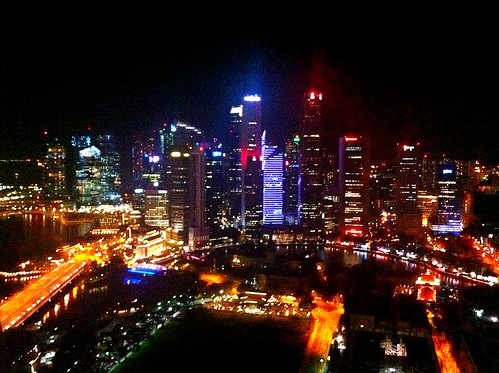
Did you manage to catch the supermoon yesterday?, asked a colleague. I didn’t know what it was until I did a quick search on the internet. Wikipedia explained this phenomenon as the closest approach the Moon makes to the Earth on its elliptical orbit, resulting in the largest apparent size of the moon's disk as seen from Earth. Oh, it seems like I’d missed the fun.
Approximately twenty four hours after the moon moved its closest to Singapore, I met an old friend for dinner. The timing was quite unfortunate, really, as I was required to attend a few late night meetings that week. But that particular night, I’d somehow managed to, tactfully, avoid the meeting. Besides enjoying a serious amount of ramen (3 whole bowls on the last count), I had a good time catching up with her. It’s been a long while since we sat down together for a meal. That few hours spent was my supermoon.
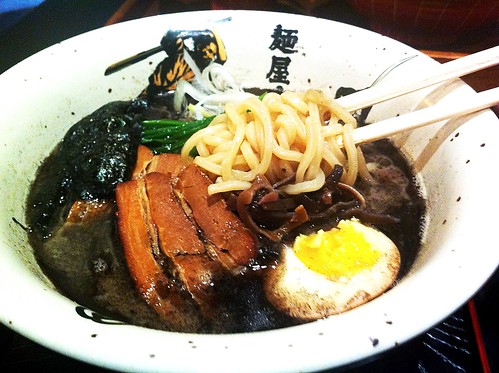
----------
Towards the end of my walk that afternoon, I still couldn’t answer the question about rewards that I’d reminded myself earlier. But recalling the supermoon, I guess despite life orbiting the constant surrounding, it is a time like this, when the extraordinary appears, that makes the journey more worthwhile.










Pre-race
A friend with an impressive race record confessed that she’s not a good runner. She explained that if she was, then she wouldn’t have suffered countless, prolonged injuries throughout her running life. If I interpret that correctly, it’s to mean that a good runner should not only be concerned about speed, but he or she must also know how to avoid drills that damage the body. I can’t agree more, but it’s always easier said than done. And do I consider myself a good runner? Definitely not.
February started well with an enjoyable run at the Hong Kong Marathon. I took a week off running after the race, to relax and catch up with friends. When I resumed training for the Brooks Half Marathon in early March, I was confident that I wouldn’t need any special preparation. It was, afterall, only 21 km. My first post-marathon run was the hardest, even though it was done at a leisurely pace and short distance. This is one of the reasons why I try not to rest for too long, because to regain the momentum is hard, naturally. And it was during this run that I’d felt pain on my right knee. A few more runs later, coupled with a change of shoes, the pain had miraculously faded. It was now mid February. BHM was a few weeks away.
Unfortunately, it was also during this time that I’d been down with a bad flu, causing me to stop running for another week, which was also my birthday week. I relied on paracetamol and lots of garlic for containment but left it to my immune system to fight the flu war (I prefer not to take any form of antibiotic unless necessary). When I did almost recover, I decided to start training again. On my first run, as I climbed my favourite slope along the usual route, I felt a sharp pain on the left knee. It was so bad that I had to stop running to stretch and jerk my leg, which didn’t help much. As I tried to continue, the pain would return, as if to tell me to STOP running. There were times when, in pain, I couldn’t even move my leg. And I would have to limp-run back home.
It was now a week before BHM. The knee would only start to annoy after the 10th km. Increasing the distance to 15 km was deadly. So, my earlier statement of only 21 km now seemed unmanageable. Without a proper diagnosis, I wasn’t able start rehabilitating. And I didn’t want to seek professional help, simply because it’s expensive. So I tried everything I knew to minimize the pain; to get me through BHM at least.
Nothing worked. What frustrated me more was that I couldn’t even locate the painful spot. It seemed to be all around the knee. I finally decided to pay a visit to the nearby clinic. The GP that attended to me had only one advice – rest and stop running. She then explained the detriments of the sport, which I thought was inappropriate, especially to a runner. I was given some anti-inflammatory pills that I’d started taking two days before the race. I did complete my first BHM, four minutes short of a new personal record. But not without pain, of course. This time, it started at the 15th km and dragged all the way to the finish line on the track of the Bukit Jalil National Stadium. After the run, it was difficult for me to walk straight. Climbing stairs was a nightmare. BHM came and gone in a blur, but I still remember the happy moments of meeting old and new running friends. There, I was told that pain in the knee is a serious issue and that to ensure a long running life, I should seek opinion of a specialist and keep in mind the possibility of conducting an MRI scan.
The meeting with a specialist went well. He was a runner, so that made me more comfortable. I was diagnosed with ITBS, or Iliotibial Band Syndrome. It’s a common injury among runners and apparently, a stretching routine will fix the problem…if followed strictly, of course. It’s not a permanent injury and no MRI scan was needed. But recovery will be slow. When I informed the doctor that my next marathon was in a month’s time, he suggested that I should start a series of laser treatments to fasten the healing process (well, to minimize the pain, at least). It’s nothing serious, really. A probe is used to beam laser light into the knee, providing analgesia and repairing tissues simultaneously. A few sessions later, I began to train again, with a knee wrap. At the same time, I’d also started to cross-train, alternating between running and swimming.
By race week, I’d managed to do two pain-free 20 km runs, in between shorter distances. At the end of my last laser session, the therapist asked about my next run. I told her that it would take place in a few days. She looked surprised, and asked of the distance that the race would cover. 42 km, I replied. By now, I couldn’t tell if she was surprised or worried. Well, good luck, she said. Yes, luck. I really needed that.
Race night
Even before the start of the race, the full-marathoners were already treated like champions. We were given special parking lots just in front of the Sepang International Circuit’s main entrance. The race was to start at 8 pm, but I’d reached at 6 pm, to avoid traffic congestion and do a proper, thorough warm-up. I can’t remember how many ITB stretches that I’d done that evening!
The starting point was on the F1 track. In front of us hung the start light, now in red. When it turns green and the gun is fired, we’ll begin our night Run For A Brighter World (that’s the theme for this race). This time, I wasn’t aiming for a groundbreaking finish, just a pain-free run.
Running along the track wasn’t as easy as I thought. There were moderate inclines, but proved to be a good warm-up before we headed for the paddock access and continued covering 5 loops (of about 6 km each) on the main road outside the circuit. At certain areas, it was completely dark, if not for the organizer who had thoughtfully placed a few human torchlights (cum supporters) to guide the runners. To be fair, we were given headlights to wear but I’m sure many, like myself, wouldn’t like to have extra weight on our heads when we run a full marathon. But out of respect for the organizer, I decided bring along the headlight, but had it strapped to my arm instead.
The undulating terrain was a challenge, but because we ran in loops, we were able to strategize better after each round. Exiting the well-lit Jalan Pekeliling, we’d entered a dark, quiet palm oil estate and here’s where the elevations got more radical. As there were only 500 full-marathoners, at times, I’d run alone for a good 200 to 300 m. At that point, I understood why some past participants described this stretch as being eery. It didn’t bother me much though. I was more afraid of an antagonizing knee, for sure.
My watch died on me by the second loop. I ran without knowing my actual pace. Like many would say, more than anything else, it’s important to run with one’s heart. And so, I did...I think.
By the fourth loop (approximately 28 km on), my calves sored and I could feel my energy depleting fast. I refueled with powergel provided by the sponsor, right before reaching the checkpoint. The climb towards the checkpoint was the hardest, given the steepest (I think) incline. Many would walk, instead of running up to the checkpoint. What motivated me to push harder here was the thought that I’d completed another loop and was moving closer towards the finish line. Despite the relatively small scale, this was the most technologically advanced race that I’d ever participated in. At the checkpoint, a large screen used as a reminder would display my name and the number of loops that I’d completed, when I stepped on the electronic mat. A glance at the screen showed that I was at least one loop ahead of the other runners who stepped on the mat at the same time! To see that I’d so far, outrun many other runners was, unashamedly, a morale booster.
Re-entering the paddock meant that I’d only 5 km more to go. As always, the nearer I got to the finish line, the more torturous the run became. By now, it was solely a mental challenge. However, I think I’d somehow accustomed to this phase. Instead of exerting more pressure onto the tired body and mind, I tried to remain calm and consistent. The MP3 player had Miike Snow’s Silvia and Cult Logic on heavy rotation now, which was awesome...and timely. At the main entrance and nearby carpark, the resting 5 and 15.5 km runners, as well as traffic marshals, cheered us on. What a fantastic feeling. It was also during this time that the sole of my left feet felt warm, as if some blood vessels had just burst. But I kept going.
3 km to the finish line now. I’d entered the F1 track again. Surprisingly, with the limited reserve in me, I was able to overtake another runner and our distance grew with each stride. There was only one more runner ahead, separating me and the finish line. I’d hoped that he would not be the 50th runner to complete the marathon. You see, the organizer had promised a special T-shirt for the first 50 full-marathon finishers. From the beginning, I knew that it would be almost impossible to achieve that kind of ranking, but...oh well, I can be overambitious at times.
I crossed the finish line to the cheers of the other runners, emcee and volunteers. To have stayed for so long (it was already 5 minutes past midnight) and for keeping the spirit high, I have utmost respect for each of them. After the 42.195 km ordeal, I’d stopped running for good that night. I was congratulated by the staff, had the finisher’s medal hung on my neck and was given a goodie bag. NOW, the knee felt more painful as the endorphin thinned. And there’s the usual fatigue on every part of the leg that had me dragging myself to the car park later.
Sitting at the pit stop to catch my breath while still sweating profusely, I began to dig into the goodie bag. I wasn’t hungry, so I’d left the snack pack for later. I was more interested in the finisher T-shirt; to see if there’s a slightest chance that I might be able to own that special edition. And I began to tear the plastic bag.
The back of my T-shirt did have a TOP 50 print (I’d found out later that I was ranked 16th in my category). It was a surreal moment. I was astonished. And doubtful at the same time. But I was mostly happy. Nevermind that I’d missed a new personal record by 5 minutes or that the speakers had to blare a Miami Sound Machine song that moment or that the wounded ITB needed some stretching that very instance. This was perhaps a once in a lifetime experience and I wanted to savour every second of it. I heaved and then, started to laugh out loud.
Post race
Reality hit hard the next morning. I woke up to very painful calves, soles and left knee. The visit to my usual masseur left me relaxed, but still broken. I’d planned to rest for a whole week.
For my ITBS, the road to recovery will be long, for I’ve unknowingly done much damage to it in the past year. But as I’m typing this, I’ve begun to run again. My mileage is reduced; in line with my recovery plan. With each run, the ITB still stings but I insist on avoiding the knee wrap. I can’t and shouldn’t depend on it forever. I’m also more aware of injuries now. I’ll stretch before, during and after a run, regardless of the distance. Also, I’m cross-training to strengthen other parts of my body. Diet-wise, I’m taking in more protein to help build muscles.

I didn’t prepare any special meal for the ENR2012, except for the above, which I’d assembled while clearing the fridge on a Wednesday morning – Somen (carbohydrate) cooked in salt water (minerals), served with freshly cracked black pepper, truffle oil (good fat) and eggs (protein).
On a recent visit to the library, I’d found John “The Penguin” Bingham’s acclaimed An Accidental Athlete and decided to give it a read. Towards the end of this biography, he wrote Running has taught me, and continues to teach me, that there is joy in accepting the fact that I am fully human. Reading this, I couldn’t help but kept nodding in agreement, smilingly.
Through running, I’d begun to understand how the human body works, though often in a hard and perhaps unnecessary way. You’ll be surprised to know that sometimes, discovering a suitable stretching method to reduce pain is just as satisfying as finishing a marathon. For me, it’s another one of life’s little mysteries solved.











The Last Emperor Theme by David Byrne played in my mind as I walked into the Forbidden City for the very first time. So affective was the composition that I’d almost descended the stairs of the Gate of Supreme Harmony to its rhythm.

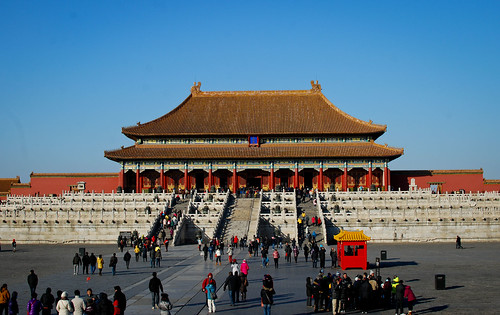

The city, or palace, was built during the Ming dynasty, centuries before the adjacent Tiananmen Square materialized. A huge portrait of Chairman Mao hangs high at the south entrance, or the Heavenly Peace Gate, overlooking the square.

In the inner city, it’s a step back into imperial China, more specifically, the Ming and Qing dynasties. The opulent, now unoccupied halls and rooms leave a lot to the imagination. Distancing myself from the boisterous tourists, I was left pensive; thinking of the intricate lives lived behind these protective yet restraining walls.

At the age of eight, The Last Emperor wasn’t of any interest to me. Though award-winning, I couldn’t sit through the whole movie. Now, with better understanding of its colourful past, I think I can...with much enthusiasm.
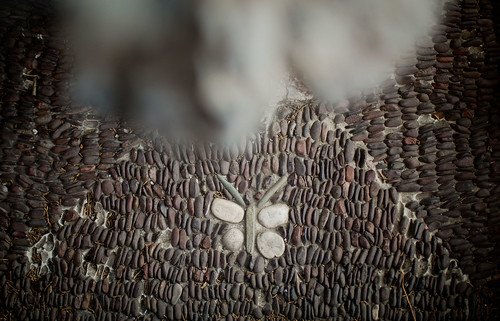











South of Tiananmen Square finds the old Qianmen Gate or Zhengyangmen, guarded by the grey archery tower called Jianlou. It has been converted into a museum now. I entered the gate to escape the freezing December wind, which had already numbed my hands and ears at the square earlier. The warmth inside the gate was such a relief. I'd planned to stay there for as long as I could and so, took time to observe the exhibits displayed at every corner in the museum. On the highest level, a centerpiece depicted the livelihood of the street across the jianlou known as Qianmen Street. For centuries, this street has been a popular choice for the well-heeled to have their photos taken or shop for high quality goods like silk shirts and shoes. Here stood a few legendary restaurants (or lao ji hao) as well, which are still very much in business today. Two of them are Quanjude, a Beijing roast duck restaurant, and Duyichu, specializing in shaomais or steamed dumplings.
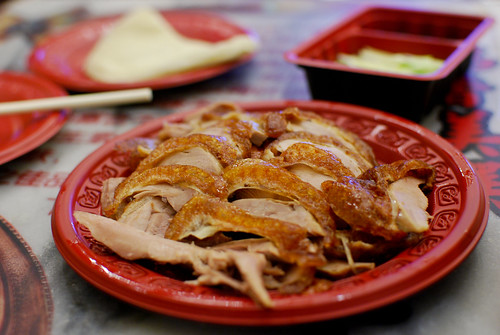
Visiting Quanjude is an obligation, applicable to both local and foreign visitors. It is, afterall, one of the oldest and most famous roast duck restaurants in Beijing. I've even seen their vacuum-packed roast duck sold in supermarkets! Quanjude uses the gua lu method of roasting, where the marinated, air-dried ducks are hung and roasted in the oven. Personally, the best part about Quanjude is that they cater for single diners, by offering individual set meals. Although the portions of Beijing duck served are usually small, with the bare meat usually disposed off, I still can't imagine having the skin of a whole duck to myself. The set meal was perfectly sized, complete with warm duck soup served in a styrofoam cup. Unlike the Beijing duck that I'd tried back home, the skin was, though skillfully carved, less moist. Another difference was the thicker flour wrap and paler, in the absence of egg. The condiments included a bundle of scallion and sweet, dense dark sauce.
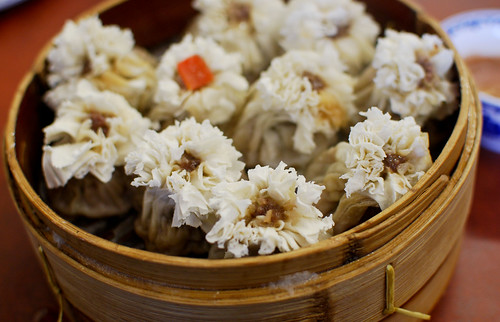
Duyichu has been making shaomais for almost five centuries now. This steamed dumpling is not my favourite dim sum and honestly, I was here just to have a taste of history. I’d ordered the minced lamb shaomai, as recommended by The Lonely Planet guide. The dumplings, fitted nicely in the bamboo steamer, looked very different from the shaomais that I’d eaten all my life. The usual thin, yellow skin wrap was replaced with a much thicker plain white flour skin, edges skillfully nipped to resemble a blooming flower. It was aesthetically pleasing. The filling was a coarse chop of meat and there was no topping of tobiko or dyed sago. If I were to draw a comparison between the shaomai of the imperial days (well, Duyichu’s version, at least) and now, I’d say that this dim sum has been refined through the years. Personally, I prefer the dumplings of today.

Qianmen Street has reopened a few years ago, after being given a facelift by the authority. Today, it is a major tourist attraction in Beijing. The lao ji haos now share the street with modern cafes and boutiques. Commercialization has returned to the street. I had a good time strolling the busy street, imagining how indifferent this old Peking street would be, back in the 15th century.










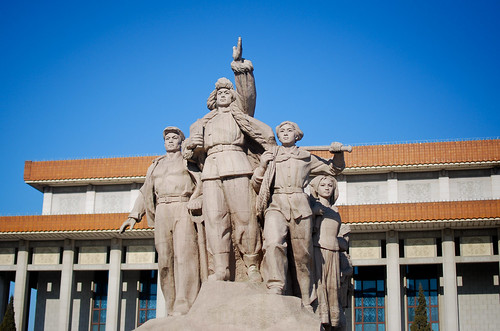
I was still reading Frank Dikötter’s Mao's Great Famine before leaving for Beijing. For obvious reasons, the book did not follow me on this trip. To say I enjoyed reading it would be wrong, but the impact it had on me was immense. The political side of the book didn’t interest me much. The struggle for survival of millions of Chinese during the Great Leap Forward did. Recently published provincial reports of failed collectivism and industrialization projects, and obfuscating officials leading to starvation, mud and faeces consumption, diseases and ultimately, death, were heart-wrenching to say the least. I wonder if a sacrifice like this is inevitable in creating one of the most important and fundamentally noble revolutions in modern history.
My first stop in Beijing was Tiananmen (or Heaven Peace Gate) Square, the heart of the Chinese Communist Party. It’s in the surrounding buildings that decisions were made and executed during the famine, and where Chairman Mao was laid to rest. On one hand, I was impressed by the vastness of one of the largest squares in the world, the centralized gigantic screens proudly showing, on rotation, the vitality and vigour of modern China, and faithful comrades bowing before the body of Mao Zedong in the mausoleum. Yet, chapters of Dikötter’s book kept haunting my mind.
Why should I take it so seriously? It’s just a holiday. I’d be gone five days later. And I am, afterall, a Chinese descendant, but a Malaysian first, Singapore resident second. I should be more concerned about the troubles back home.
In this trip across the cultural center of the middle kingdom, by learning its history, I’d better understood the Chinese. Some of us have been, for the longest time, making insensitive remarks and ignorant about some of their practices. Ask yourself - would you have done the same if you were one of them? If you’d taken time to know and understand them, then you most probably would.












The idea of visiting this 3 Michelin stars restaurant came just as I'd signed up for the Hong Kong Marathon. I decided to go for their more affordable lunch menu, which is not available in Singapore, on the last day of my trip. It was the first 15th day of the new Chinese lunar calendar and as I walked from Sheung Wan to L’Atelier at The Landmark, lion and dragon dances were seen on both sides of the road. The roaring drumbeats and clanging of cymbals enlivened the otherwise mundane surrounding.

- Lunch At Your Own Composition -
Amuse bouche
Appetizer - Crispy pork cromesqui, acidified condiments with arugula
Soup - Daikon veloute with black truffle and beetroot
Fish - Fine lobster veloute, Tarragone royale and Paris mushroom
Meat - Veal cheek terrine with black truffle, "boutons" mushroom and creamy sauce
Dessert - Chestnut mousse with raspberry meringue and chestnut ice cream
Tea and confectioneries
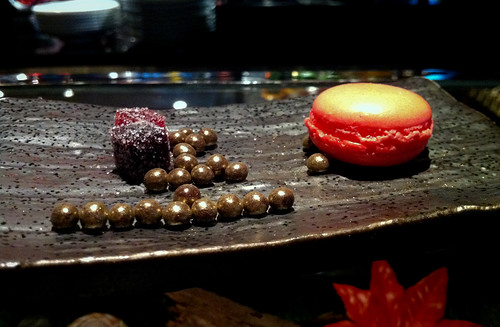
It's well-known that The Landmark is fashion-centric. Most visitors and employees dress beautifully, some strangely, here. There were also living replicas of the boutiques' display. I was, obviously, not one of them. In my worn cargo pants, sweater and patched backpack, I took the escalator to the top of the building that led directly to L’Atelier. At the reception, and without a second glance, I was ushered into the studio. They even sat my backpack next to me. It was a nice gesture, I thought.
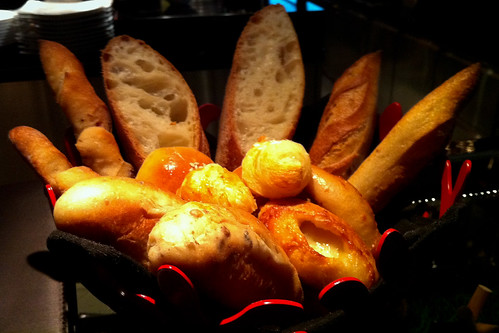
I'd known that the bread basket would be a highlight at Robuchon, but was not informed of the size. It's important not to empty the basket before the dishes start rolling in. And that's not easy, for the wafting aroma of a variety of freshly baked bread had me wanting to try each and every one of them. My favourite was the thumb-sized cheese bun, which was light and fluffy enough to be called a puff instead. In fact, it was the reason I headed for Le Salon downstairs - to pack some home. Alas, they were not for sale there.


I had the most expensive prix fixe set that day but if my selection (or composition) of dishes was to be graded, I would have received a pass, at best. What was I thinking choosing 2 veloutes? I wasn't craving for cream that day, that's for sure. On the bright side, both veloutes were rather distinctive. The daikon veloute came subtle in taste, perfumed with a good dosage of truffles. Also, it turned out to be a rather good dip for the mini baguettes. The other veloute, the lobster, was a briny-addictive, coral pink ensemble, centered with an alternating arrangement of sliced lobster tail and minced lobster balls. And then, there was more cream from the veal cheek terrine. Luckily, it was not another bowlful of it, but rather, a light dressing for the terrine of tender cheeks. If I were to choose the most memorable dishes of the lunch, it would be the amuse bouche and appetizer. Served in a petite cup, the amuse bouche might not be visually appealing but the taste of the smoke-infused (most probably from the bacon crisp) thick white cream was a wonderful surprise. And a good complement to the milder, earthy taste of asparagus. The appetizer was a cromesqui, filled with finely chopped pork. I believe it's cooked in its own savoury juice because not much seasoning was detected. It being crispy and savoury, was best served with something sweet and sour, like their acidified vegetables. Dessert was a dense chestnut mousse paired with some contrasting tangy raspberries and wafer-thin meringue.

Throughout lunch, I was amused by the conversation between two Caucasian ladies who sat next to me. It has nothing to do with the topics but their fluency in both Cantonese and English was admirable and interestingly engaging. Their choice of dishes was also more diversified, and from their exchanges on the dishes, one can tell that they are regulars here at L’Atelier. They'd left when I was halfway through my dessert. The dark row was now left with a Chinese couple with a thick American accent and myself. As quietness set in, I began thinking about L’Atelier, and the Michelin stars. If three stars represent an exceptional cuisine, worth a special journey, was L’Atelier worth a special journey for me?
This lunch experience was indeed exceptional. Everything was top-notch; from the service to the execution of the dishes to the ingredients used. Even the price was attractive. And to lunch at this particular Robuchon after completing a run around Hong Kong made it even more special.
L’Atelier de Joël Robuchon
S315&401, The Landmark,
15 Queen's Road Central
Hong Kong










食得愉快, 跑得越快
24 Feb 2012 12:40 AM (13 years ago)

The theme, in Chinese, for this year's Standard Chartered Hong Kong Marathon is 從 心 出 發, 跑 出 信 念. It can be loosely translated as run from the heart to find your faith. The English theme, however, sounds much simpler - Run For A Reason. Now, why the English theme is not a direct translation of the Chinese version or vice versa is beyond me. I'm reminded of some Hong Kong drama series where the English translation of the Chinese title doesn't make any sense. And laughable too, sometimes. Confused and dissatisfied, I decided to create my own theme for the SCHKM2012. It should revolve around food and of course, running. While walking around Sham Shui Po after having 2 satisfying meals to celebrate the completion of my first SCHKM with a new personal record, I came up with this - 食得愉快, 跑得越快 or eat enjoyably to run faster.
食得愉快. Indeed, I had a great time savouring local delights that I missed (or was unaware of) the last time I visited Hong Kong. That was 7 years ago. During the last 2 days prior to the marathon, I'd eaten so much that I had to make a toilet stop around the 26th -27th km of the race. That caused me to lose about 5 minutes, which may be the main reason why I missed the sub 4-hour mark (by just 52 seconds, by the way). But that's alright. I wouldn't trade the trail of good food for that mere 52 seconds, or more.
Ho Hung Kee, Causeway Bay (何洪記, 銅鑼灣)
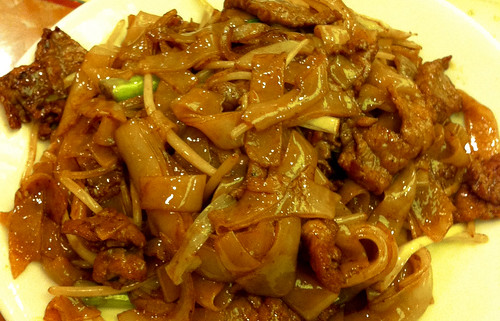
I was at this decades-old restaurant for the stir-fried rice noodles with beef, not knowing that Ho Hung Kee is more well-known for their congee. In the end, I ordered both. The large plate of fried noodles glistened under the dim yellow light. It was oily but only to provide a nice aroma that complemented the smooth strands of rice noodles and beef. It'd be a waste if this was not eaten with the mildly hot, tangy chilli sauce. I must have finished half a jar of the sauce. Besides the noodles, there was also a sizeable bowl of congee waiting to be tried. I don't think many will order that much for 1 person. So, it's only natural that I'd attracted unnecessary attention from the other customers. The fact that I was seated at the center of this tiny shoplot didn't help much to conceal the glutton in me. So, it was my responsibility to put up a good show by finishing both dishes. It wasn't difficult, especially when the slices of pork liver and cuts of fallopian tube were absolutely slithery and springy, and the Cantonese congee itself being refined and just slightly starchy.
Lok Yuen Beef Ball King, Mong Kok (樂園牛丸大王, 旺角花園街)
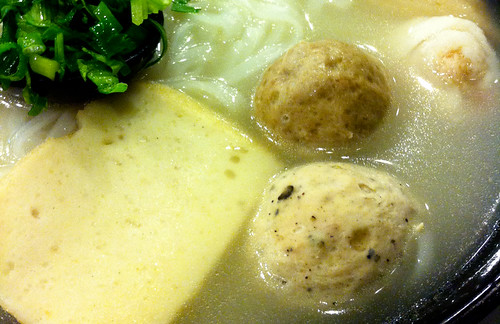
Apparently, the unforgettable ping-pong beef balls featured in Stephen Chow's God of Cookery were inspired by Lok Yuen's beef balls. I don't know if that's true but since the shop was just a 5 minutes walk from my hostel (and that I'm a big fan of that movie - I'd watched that 4 times in the cinema!), I'd decided to give it a try. The variety of meatballs on the menu was impressive and being a first-timer at Lok Yuen, I thought it'd be good to order the 4 Treasures Bowl, as it has a bit of everything from the menu. Unlike the movie, there was no squirting of superior soup or juice when I took a bite of the ball. And surprisingly, despite all the interesting variations, it was the simple black pepper beef ball that I found most flavourful.
18 GRAMS

It was my lunar birthday. Being half Hakka, I was ordered to consume 2 eggs that day, to symbolize the passing of another year of existence, be it good or bad. This ritual is easily practiced back home, where cooked eggs can be bought everywhere - nasi lemak/mixed rice stalls, coffeeshops, etc. But what about Hong Kong? I thought the steaming herbal egg was the most convenient option but the higher authority wasn't pleased, perhaps thinking that herbs are associated with medicine and that's inauspicious. A quick search on the internet (keywords used - egg, hong kong) led me to an actively branching cafe called 18 Grams. Their signature dish - eggs benedict. Perfect. Usually, I would just eat any 2 tasteless eggs to fulfill the requirement but this time, I'd totally enjoyed my lunar birthday eggs. The components matched one another really well - lightly vinegar-ed creamy hollandaise sauce, runny yolks, garlic-perfumed sauteed spinach and thick ham slices on a toasted pillow-soft muffin. What a fantastic start to my final carbo-loading day here in Hong Kong.
Mak An Kee Noodle, Wing Kut Street, Central (麥奀記 (忠記) 麵家, 中環永吉街)
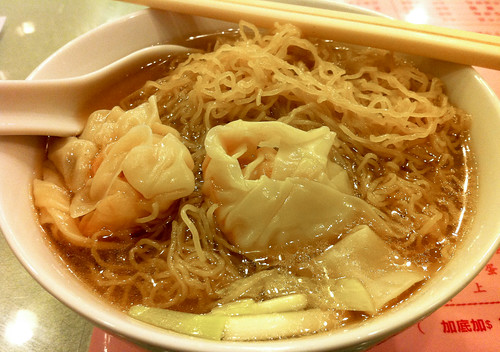
Since it was just a day away from the race, I thought I should take it easy and spent the afternoon strolling along Des Voeux Road, starting from Sheung Wan MTR towards Central. There were many narrow but densely populated lanes along the way. As I passed Wing Kut Street, I noticed a group of people standing outside a tiny restaurant. It was Mak's, the popular wanton noodle house. This may not be the main shop or under the same management (due to family feud), but this serendipity should be celebrated. It was the most fundamental (and smallest) bowl of wanton mee I've ever had. Accessorized with just a few strands of yellow chive leaves and some juicy wantons, this was, to me, the best way to showcase the springy egg noodles and umami broth.
Chong Kee, Gilman's Bazaar, Central (忠記粥品, 中環機利文新街)
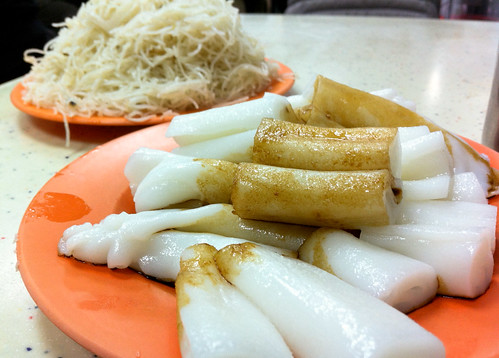
In the end, the strolling plan failed. I should have known that Des Voeux Road is the artery of Central Hong Kong and that it links to many interesting places on the northern side of the island. Diverting to one of the busiest lanes, I found myself walking towards the mid-levels escalators. If not for the malfunctioned set of escalators nearing the peak, I would have wanted to go on until the end, despite the quieter surrounding, just to see where it would lead me to. I descended the mid-levels via a different route. It was bustling and steep, with old grocery shops and wet markets lined along the way. For me, this was exemplary of the entrepreneurial spirit of Hong Kong. Returning to the low-level and after crossing Queen's Road, I was now at Gilman's Bazaar, which is not too far from Mak's. It was time for another round of carbo-loading. I entered Chong Kee and had some fried rice vermicelli and cheong fun. There were a few bottles of different sauces on the table and I chose to squeeze some peanut (or sesame) sauce onto the vermicelli. The combination tasted wonderful! Who would have thought? Another thing that I'd realized during this trip was that the taste of rice is very much prevalent in Hong Kong's cheong fun. Perhaps the ingredients used are different (less starch, more rice?) and for the better, provided a melting texture.
Random shop along Fa Yuen Street

I decided to cap off the carbo-loading day with some rice. This shop may not be a household name along the busy Fa Yuen Street, but it offered what I needed. Plus, I didn't have to queue to get a seat. This steamed rice with pork dinner, drizzled with some soy sauce, was quite good, actually. Then, it was time to rest. The race would start in less than 10 hours.
Lau Sum Kee Noodle, Sham Shui Po (劉森記麵家, 深水埗)

My first, proper post-marathon meal. I thought it'll be interesting to skip the usual Mongkok-Tsim Tsa Tsui-Central-Causeway Bay belt and explore a new area instead. Sham Shui Po was a good option, as it was not too far from Mongkok and filled with restaurants (including one that offers snake soup), and even more wholesalers. There's also a night market near the MTR exit; just as crowded as Ladies' Market. I came to Lau Sum Kee to try their dry-tossed egg noodle that is sprinkled with dried shrimp roe, with stewed beef brisket. The smoky aroma of the roe was unique, but it was the spontaneous choice of topping, the brisket, that was the highlight of my visit. The soft pieces of meat came with tendons too and the dense, sweet/savoury brown sauce was very tantalizing. I wanted more!
Wai Kee Noodle Cafe, Sham Shui Po (維記咖啡粉麵, 深水埗)

Hong Kong, like Japan, is single diner-friendly. One can, at any time, share a partially occupied table. At Wai Kee, I'd shared a round table with 2 families and 1 couple. How cool is that? This coffeeshop is insanely crowded. They own a few shops along Pei Ho Street and there's perpetually a queue outside every shop! Even Donald Tsang dines here. The menu written on the wall was extensive but mechanical - basically a mix and match of ingredients. I had instant noodle with beef and ham, toast and milk tea, the quintessential char chan teng fare. Generally, I'll shun such places because I don't find DIY-able food at an inflated price appealing. But I liked Wai Kee. Their noodle dish was comforting. The broth was light but flavourful (the result of sufficient simmering and ingredients used), despite the unattractive, unsifted residual. If only our local char chan tengs can be just as good as Wai Kee.
Sheung Wan Cooked Food Center
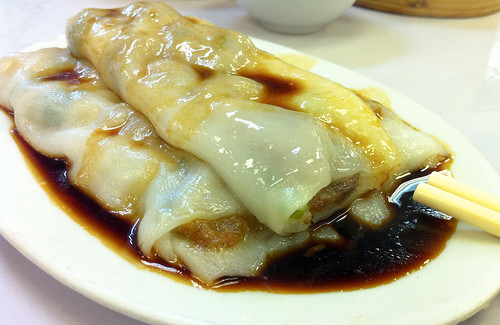
Dim sum wasn't on my list this time. There were just too many new things to try. It was the last day of the trip and just an hour before I splurged on one of the most expensive lunches I'd ever had. Walking around Sheung Wan to hunt for dried scallops and oysters, I stumbled upon a Cooked Food Center. A familiar sight in Singapore, but a first for me, here in Hong Kong. I had to explore this building. The food center is placed above a wet market and surprisingly, air-conditioned. Many stalls remained closed (it was only 10 am in the morning) but those that were opened enjoyed brisk business. A stall selling Chiu Chow dishes was especially crowded. Men in safety boots and uniform were picking their dishes, carrying a mountainous bowl of white rice in hand. I would have joined in the queue if not for the planned lunch date. Dim sum seemed like the best option as it was the least filling, so I went ahead and pointed to a few bamboo steamers at the adjacent stall. The stallkeeper advised me to keep my order minimal, or else the dim sums would turn cold before consumption. What a different dim sum culture they have! Back home, we would order as much as we could and yes, leaving them cold and dry on the table. This is just a typical stall in the food center and there were not many customers around. But the beef balls (one of my favourite dim sums) were as fresh and sweet as the ones I had in a Hong Kong hotel. Also, the balls were served with a pouring of black vinegar which brought an interesting dimension to the meatballs. Having delicious, steaming dim sum at an unhurried pace, this was an enjoyable yum cha session I've not had in a very long time.











Two weeks ago, when I slipped my left foot into the work shoe after a 20 km run, my sole felt sore. It was bad enough to keep me agitated throughout the day. I convinced myself that the pain was temporary, like how my thighs would strain or ankles sprained after a long run, and that they would self-heal in a matter of days. By the following week, which was only 6 days to the Standard Chartered Hong Kong Marathon, the pain worsened. I tried every common treatment that I could think of - including icing the foot. The numbness caused by the cold did temporarily hide the pain but would return to haunt me the next morning. It was depressing waking up to this. Despite the pain, I still managed to complete the obligatory pre-marathon long distance run, 4 days before the race. The pain was most excruciating in the final 10 km. Maybe it was the new pair of insoles that somehow changed my pronation and caused the pressurized ligament to inflame or tear. It could also be caused by my new lightweight racers, since there were less cushioning. Or that I’d simply overtrained this month, in preparation for my first Hong Kong Marathon. In January, I’d upped my running mileage to 322 km (that’s about 10 km daily), which might have been more than my body could handle. But there were no signs of resistance, so I assumed that it was already adapting to longer, more frequent runs. How unfortunate that it had to happen now, at the time when I was in the final preparation stage for my first marathon abroad.
I’d kept the injury to myself because at that point, I thought no one would be able to help. And it was too minor (and expensive) to seek professional help. On one of the tapering days, as I filled a pail of water with ice, XLB asked if I was going to soak my clothes in it. I explained that it was to dip my injured foot. She then asked if I had plantar fasciitis (an inflammation near the heel area) and shared her experience on this condition, which really did put my injury into perspective. Perhaps I did inflame my plantar fascia, given some of the symptoms that she’d described. Her miraculous Korean plaster had significantly minimized the pain for a whole day. But I knew that it wasn’t the best long-term solution. The next day, I tried scanning as many websites and forums as I could on plantar fasciitis and its treatment, mostly in form of physiotherapy. In the next 2 days before departing for Hong Kong, I began a set of self-treatment – taping, stretching, rolling, wearing heel cups, etc. The technique of holding/releasing a towel with my toes was rather effective. The pain had gradually reduced. At night, I would tape my left foot to restrain movement and prevent it from drooping when I sleep.
By the time I boarded the plane to Hong Kong, I was still unsure if I could complete the race. The pain on my left foot had subsided, but when I start pounding the pavement on Sunday, the inflammation may return and for worse, tear completely whatever that’s left of my plantar fascia. But it was too late to pull out now. I just had to be more cautious on race day.
Arriving on Friday afternoon, I proceeded to Victoria Park at Causeway Bay to collect my race pack. It's always the same for me - seeing my name printed on the runner's tag heightens the excitement that will follow me to the starting line. That made me forget about the injury for a while.
It was 12 hours before the race and I began to pack the essentials into the recyclable race bag. As I tied the timing chip to my shoe, I was contemplating on removing the insoles that I'd suspected of causing the injury and replaced them with the GT-2160's (which I'd just bought from Sogo Causeway Bay at an amazingly low price). I tried walking in them around Mongkok that night. My left foot felt more comfortable now but I reminded myself that this new combination of insoles and shoes was untried. In the end, I'd decided to take the risk.
Race day. I had a sound sleep the night before. Of course I did. I'd walked around Kowloon and Central for hours, only stopping for some good old local food. The feet were behaving rather well and that really lifted my spirit. The light shower was cooling and the temperature was around 16 deg C. It was the best weather condition that I'd ever had on any given race day so far.
At the waiting pane, the paparazzi were surrounding one of the full marathoners - not an elite runner but local celebrity, Edison Chen. I think he was running to raise fund for charity. For myself, I decided to participate in the Hong Kong Marathon after reading some very positive feedbacks on the organization and weather, and that it's only a 4-hour flight from Singapore. Since receiving the acceptance letter, I'd been looking forward to experiencing this world-class marathon that attracts many runners from this region. I'd also kept in mind the much discussed hilly, impeding terrain.
Starting from the 2nd km, we ascended about 70 m to reach the peak of the Stonecutter's Bridge before turning onto the iconic Tsing Ma Bridge. The next and last bridge to cross before returning to Kowloon was Ting Kau, the highest point of the race at an elevation of about 90 m. This trinity of bridges route made up almost half the marathon distance and many runners were seen struggling from one bridge to another, given the challenging elevations. Words of encouragement were exchanged (mostly in Cantonese) and I found that to be rather inspiring. Reaching the top of Ting Kau, I was still doing alright, with a painless left foot and regulated breathing.
According to the elevation chart, we should enjoy the descend from the top of the final bridge onwards, as we make our way back to the city. That was the reason I'd decided to channel my energy on the first half of the race, knowing that the last half would be relatively easier. But that was not the case. In general, the Cheung Tsing Tunnel - Tsing Kwai Higway - West Kowloon Highway - Western Harbour Tunnel route was a 90 m drop spanning 16 km, but the intermediate slopes at around the 29th, 31st and 33rd km added significant resistance to this second half of the race. Some runners would walk to rest before resuming to climb these slopes. The merging of the full and half marathon routes at the West Kowloon Highway, which caused a small congestion, was another obstacle to overcome. To say that I was not losing focus at that stretch would be a lie. I kept reciting a simple mantra in my mind to vacuum off the strain on every inch of my legs. And by the 32nd km, I'd turned on my MP3 player.
More stopped to stretch and apply ointment on their tired legs in the Western Harbour Tunnel. This is the tunnel that connects Kowloon to the Hong Kong island and in this course, the final stretch before running on the milder roads of Central. It was time to push the hardest.
Reaching the end of the tunnel, I KNEW the struggle was over as I'd studied the course elevation. The last 4 km would be easy, just like my usual morning runs, I told myself. The gel bars were still untouched. But right in front of me was a high flyover, filled with a sea of slowed runners. Was it my imagination? How was that possible? A closer look at the chart later revealed that there were indeed more erratic elevations leading to the finish line.
Back to the last 4 km. From my few experiences, I'd learnt that I should run at a constant pace in the final few kms, in order to not lose steam in the midst of the excitement and euphoria of being close to completing a marathon. So, I ran patiently, steadily, crossing one flyover after another, towards Victoria Park.
Rapturous supporters filled both sides of the route from Lockhard Road onwards. It's a sign that we were nearing the end of the race. The surrounding of classic shophouses and colourful signboards that fill many postcards of Hong Kong was beautiful. This was the moment that I'd been waiting for in the Hong Kong Marathon.
The finish line was about a hundred meters ahead. As I ran towards it, I started to recall the 2 weeks leading to this point, feeling ever grateful for this injury-free, enjoyable race.
I missed the sub 4-hour mark by 52 seconds but managed to achieve a new personal record by shedding about 28 minutes off my previous best timing at the Standard Chartered Marathon Singapore.










The Champagne Pool is one of the major attractions at Wai-O-Tapu Geothermal Wonderland, which is located near Rotorua. When I came across a photo of the multicoloured pool in the travel guide, I knew that I had to somehow include this in my compressed itinerary. So, just a day after visiting Milford Sound, I took the earliest flight back to the north island and drove about 300 km from Auckland, passing orchards and farms, to arrive at Rotorua on the same day. Just another mad, exciting day in New Zealand for me.

I could have driven through the quaint town of Rotorua to reach Wai-O-Tapu that late afternoon, as it was just over 20 km away. But I would only have a few hours to complete the trail and less time for photography. That wouldn't do justice to the wonderland. So, I decided to do that the next morning instead. I stayed in Rotorua for the night and managed to visit the beautifully restored Elizabethan museum of Rotorua, which used to be a bathhouse. Here, I'd learned quite a bit about Rotorua and the Maoris. The award-winning Polynesian Spa was just a few steps away, so I thought I should treat my worn body to a dip in the alkaline rock thermal pool. Sitting in the minerals-rich water, enjoying the serenity around the lake spa, with a pretty sunset view of Lake Rotorua and the cool breeze of late spring was most relaxing...until a large group of noisy tourists entered the compound. I ended the day with a dinner at the popular Capers Epicurean cafe. I had one of the day's specials - a creamy, citrus-scented dish of fettuccine with smoked salmon and prawns. It was a brilliant combination, I must say. So was the dessert of coconut and passion fruit cake crusted with almost flakes and served with a dollop of yoghurt. What an enjoyable night it was. Perhaps I should have more slow-paced, relaxing days like this when I'm on vacation ...... Nah.

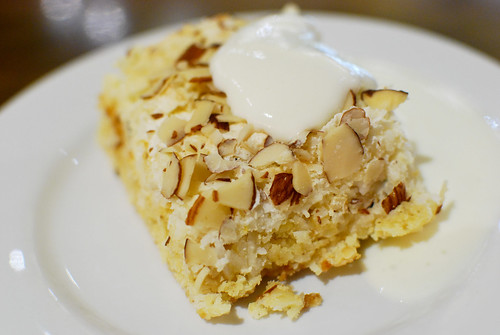
The next morning, I reached Wai-O-Tapu just minutes before the doors were opened. Yes, I was really excited.

Walking around the living geothermal spot was like revisiting a science class. Though unpleasant, the first smell of hydrogen sulfide had me chuckling as I recalled the day when our science teacher, Mrs Yong, tricked us into inhaling that strange, resultant gas emitted from a test tube. The colours of the rocks represent the different compounds spewed from the earth's core. It's amazing how the deadly, violent movements of the earth had shaped such unique formation of pools, craters and geysers. They were magical. It's no wonder that they'd inspired the locals to christen them with imaginative names such as the Devil's Ink Pot, Artist's Palatte, Oyster Pool and Bridal Veil Falls.
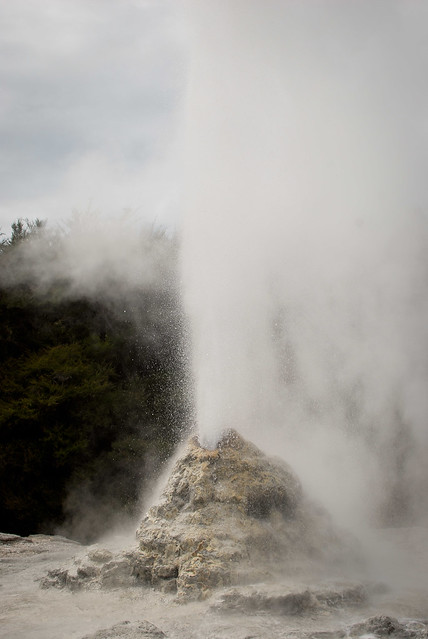
It was nearing noon when I'd watched Lady Knox Geyser erupted and visited the nearby boiling Mud Pool. I had only a few more hours in Rotorua before driving back to Auckland. Tomorrow, I'd be returning to Singapore. There was only enough time, barely, to visit one more attraction in Rotorua. It was between a Maori village and the Waimangu Volcanic Valley.

Unlike Wai-O-Tapu, there was much less visitors at Waimangu. I’m guessing that it’s due to the more challenging trail, which may not attract certain groups of visitors. Eco-tourists, however, will fall in love with this relatively untouched, young geothermal valley. I had two hours to complete the easy-walking trail, in order for me to reach Auckland before nightfall. But I couldn’t resist the longer, tougher Mount Hazard trail. So, I had to move really fast.

Waimangu was a teaser. With every step of the trail, there’s something interesting that’s worth one’s attention. The climb to the top of the first hill was rewarded with a clear view of a black-water pool covered almost completely with red algae. Descending the hill, the ethereal Echo Crater and Frying Pan Lake await. The steam arising from the lake was such a spectacular fairyland-like sight. I wished to have spent more time here, to enjoy this view, but I was still far from the end of the trail. I had to move faster. The steep climb along the Mount Hazard trail is not fun – when one’s in a hurry. Patches of sweat began to appear on my shirt and I was gasping for breath as I’d reluctantly overtaken the slower climbers. But I was thankful for two things – my trusty pair of trekking shoes and good signage. There must be a reason for the creation of this difficult trail. Indeed, it’d led me to the steaming, azure Inferno Crater Lake. Seeing this beautiful lake for the first time was unforgettable. The vastness of the lake was not meant to be captured on my limited lens. So, instead of trying hard to get a good shot of the lake, I just stood there for awhile and enjoyed the view. The few German photographers standing next to me must have had better luck shooting the lake with their telescopic lens. Descending Mount Hazard to return to the main road was easy. I’d doubled my speed and finished the trail, passing the stunning Marble Terrace, Buttresses and Warbrick Terrace, within my targeted time. Waimangu was a living fantasy and it certainly looked better than in the guide books. I was glad that I’d chosen to come to here.
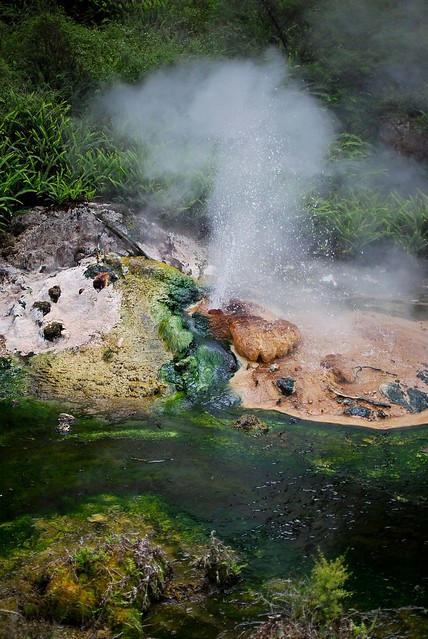
A collision of two sedans had slowed the traffic along the highway tremendously. It took me more than 4 hours to reach Auckland. The number of cars increased as I entered the city center. At the major shopping belt of Auckland where my hostel was located, neon signs and headlights filled the night. Streams of locals and tourists were gallivanting around the main streets. Restaurants and shops were buzzing. I had returned to familiar grounds.
Auckland was very different from the small towns that I’ve visited in the past 8 days. The noise and chaos made me miss the more peaceful and beautiful side of New Zealand. I returned to the hostel after having a hot bowl of chili from Wendy’s that kept me warm for a few hours. I decided to sleep earlier as I had to return the rental car before catching my flight back to Singapore the next morning. But before that, like every night throughout this vacation, I would lie in bed to recall and view all the beautiful sights of New Zealand on my camera’s LCD. The only difference was, tonight, I had no new adventure to look forward to the next morning. But I still slept with a big smile on my face as I reminded myself that I’d gained some incredible experiences in this journey across the land of the long white cloud - bungy jumping in Queenstown, walking on ice at Fox Glacier, cruising the majestic Milford Sound and living a fantasy at Wai-O-Tapu and Waimangu.
Here’s the link to my set of photos of New Zealand.










When you’re in the adventure capital of the world, you live it.
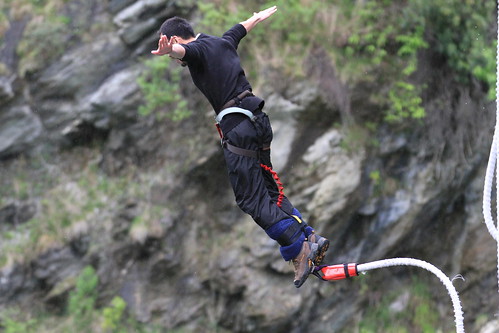
Sometimes, when travelling, the mind is best left at home. Until the day I jumped, I was still assessing the risks of this crazy thing called bungy jumping. It was disturbing and had affected the first two days of my holiday.
Returning from Fox Glacier, I made my way to the jump base, the Kawarau River Bridge. I was feeling a little nervous but excited at the same time. The radio was playing a string of ballads, which did nothing to pump up the excitement. In fact, it was rather annoying. I turned it off, but the silence encouraged negative thoughts. I drove faster.
At the base, I quickly made my way to the registration counter, paid the fee and headed straight for the jumping platform. The efficient staff got me strapped with a few harnesses in a matter of seconds, while a group of Japanese tourists looked on. They thought I was Japanese and gave me some encouragement. A few of them seemed worried. I stood up, hopped to the edge of the wooden platform and looked down. If not for the strong current, the beautiful emerald Kawarau River below would have calmed me a little. The late afternoon began to feel cold too, as the rain got heavier.
Almost immediately, the staff signaled for my jump. Dive well, bro, he said. It was time to take a leap of faith.
Much earlier before the jump, I’d decided on a Superman dive. But in the end, it turned out to be a typical, instinctive dive instead, which lacked style.
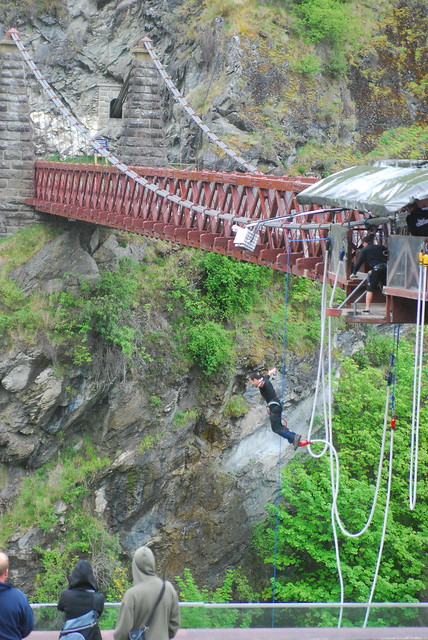
The first few seconds of the free fall were the best. I felt light; like one with the wind. It was surreal. This joy, this adrenaline rush was unexplainable. As I dipped into the river, the rubberized rope, upon reaching the limit of its stretch, contracted and I was pulled up slightly. The jump was over.
A boat rowed by to transport me to the river bank. From here, it was a long walk back to the jump base. I’d guessed that this distance was designed to help traumatized jumpers to relax and recover. I was just happily singing along the way, striking off another action item on my bucket list.
It was only when I’d watched another person jumping off the same platform that I realized what I’d done just minutes ago. Indeed, I’d left my mind, and acrophobia, in the car.

FergBurger is a fantastic place to fill the stomach after an adventurous day in Queenstown; provided one gets a seat, of course. The display of MTV-style sports programmes and upbeat music made the small restaurant cool and lively. But of course, it’s the long list of mouth-watering burgers accompanied by sides of fries and beer that makes FergBurger a must-try for every visitor to Queenstown.

I could have just ordered any other burger but decided to go all out for the biggest burger there was at Ferg’s. Afterall, that’s what living in the adventure capital of the world is all about, isn’t it? I'd like to think of it as my Man Versus Food moment.
It’s called the Big Al. I equated its monstrous size to 2 Big Macs. I wasn’t able to count the number of prime New Zealand beef patties in the burger but the menu stated a double serving. There were also layers and layers of fried bacon, cheese, beetroot, tomatoes, onions and lettuce. Extra flavours were provided by the generous amount of relish and aioli. Biting into the thick Big Al itself was a challenge. Then, I had to deal with the layers that kept falling out with every bite…because it’s just too much to handle. It’s interesting to have the egg yolk flowing out on one side of the burger and the pinkish beetroot/aioli mixture squirting from the other. It was a mess, a delicious mess of course. I’d returned a few days later to try the smartly named The Codfather; a burger that consists of beer-battered blue cod, dressed with dill tartar. The fried cod came exceptionally aromatic and paired wonderfully with the tartar sauce. It was perhaps the best fried cod I’ve ever had so far.

Just next to Ferg was a dessert bar called Lick. With an overstuffed stomach, I should have just walked pass the bar and continued on for a few miles more around Lake Wakatipu to help ease digestion. But instead, I stopped by for some gelato. I’m glad I did (sorry, stomach). I had two very smooth and refined scoops at Lick; boysenberry and feijoa flavours. In fact, I’ve never had mediocre gelatos or any dairy product in New Zealand.

It was only at night, when I laid in bed recollecting my day, that I realized how exhausted I was. It began with a 5-hour drive from Fox Glacier to Queenstown, followed by the bungy jump, an accidental visit to Arrowtown and window-shopping around central Queenstown. The next morning, I would be joining a day-tour to Milford Sound. The thought of taking the backseat for once was very much relaxing. I looked forward to the breathtaking fiorland, which was my final stop on the south island of Aotearoa.











Nakhon Kitchen
12 Jan 2012 6:39 AM (13 years ago)
The thought of Nakhon Kitchen whets up my appetite easily. And I've only been there once.

When I order pineapple fried rice, I often (if not always) find myself asking - where's the taste of pineapple? It's usually just yellowed, dry (or oily, take a pick) rice stirred with prawns and green peas, and served in a halved, hollowed pineapple. Here, my first spoonful of rice came with a burst of sweet/sour juice from the pineapple cubes (be it canned or fresh) adding both taste and moistness. That's pineapple rice, literally. A good one at that.
I've learnt that the favourite meat among the female patrons here is not necessarily a dish, but for me, I've got my eyes set on the spicy minced pork with basil leaves. It's a simple stir-fry, perfumed with a handful of Thai basil leaves and sufficiently dressed in a mixture of savoury sauces. This is a dish that's compatible with any form of carbohydrate; rice, bread or noodles.
Perhaps it's the contrast between the colour of the plates and the food that....no, let me take that back. It's still their technique of the getting right fillet texture and the formulation of sauce that made the fried fish with sweet chilli sauce a winning dish. Of course, as mentioned, it was visually appetizing as well.
The small shoplot was atmospherically Thai; from the utensils to the decorations to the music. One can tell that the owner made an effort to impress the customers with these details. With food so good, that's not required. I think the neverending queue will agree.

Nakhon Kitchen
Blk 212, Hougang Street 21
#01-341
Singapore 530212










4 December 2011 (Standard Chartered Marathon Singapore)
Once again, I’d followed a high, good fats and potassium-rich diet of salmon, avocado and potatoes in preparation for race day.

I was stuck in the human jam along Orchard Road. Under the bright Christmas lights, I was bewildered, frustrated and upset. My pace was negligible. It was painful to look at my stopwatch. Come on, compressing 20,000 marathoners on the compact city roads has got to be a bad idea. And to have just 8 baggage deposit counters was an obvious sign of mismanagement. Still walk-running somewhere between South Bridge Road and Cecil Street (that's 4 km from the starting point), I had a thought that followed me a long, slow distance. Was I missing the point? Shouldn't I be enjoying the run instead of eagerly wanting to better my personal best time for a full marathon? NO! I didn't come untrained. I wanted to hit a new PB. I wanted to cap off this amazing year with a PB. My response made me even more upset. For me, this was the most anticipated run of 2011. After completing the 10 km and 21 km categories in 2009 and 2010 respectively, I'd plucked enough courage to challenge myself to run the marathon distance. The Putrajaya Night Marathon and months of training boosted my confidence further.
The human traffic eased towards the 8th km. So did my mind. Now, I decided, was the time to recover, to compensate for lost time. I began to accelerate.
By the 13th km, I'd entered East Coast Park - the longest stretch (about 20 km) of the full marathon course. Despite the narrow lanes, runners were more dispersed now. The 5-hour pacers were now in sight. I quickened my pace. As I overtook them, I was once again filled with optimism. Earlier disturbances were washed away with the endless flow of sweat. Observing my average pace, I estimated the time needed to reach the 4.30-hour pacers. It wouldn't take too long.
Indeed, I managed to catch up with the pacers and later, overtook them. To achieve a new PB, I must always stay ahead of them until I reach the finish line. As a bonus, the 4:15-hour pacers were not too far in front too!
Besides achieving a PB, I wanted to finish the race injury-free as well. However, I didn't manage to do any pre-race stretching due to the delay at the bag deposit counter. That got me worried. There was nothing that I could do, but to listen to my body with every stride.
At the 34th km, before crossing the bridge to Marina Barrage, I felt a prickle on my right inner thigh (there must be some Latin name for the specific muscle, I'm sure). It's the familiar sensation I get when I do longer runs. Sometimes, it would disappear but unfortunately, on that day, the pain worsened. Who would have thought that a tiny piece of cramped meat like that could affect one's performance? Well, it did. Running, from that point on, felt like driving a car with one locked wheel. I had no choice but to slow down, constantly and rhythmically swinging my right leg to reduce the pain. I gulped two packs of energy gels and had cups of isotonic drinks, hoping to level the amount of potassium in my body, which may (or may not) ease the cramp.
As I was thinking of ways to minimize the pain, I didn't realise that the 4:30-hour pacers had caught up with me. The sight of their bright yellow singlets and grey balloons was unwelcome and alarming. I can't let them overtake me, not at this point. Like a prey running for its life, I pushed on…hard. There was no turning back to check on the pacers or treating the thigh now. I just ran - up the Heartbreak bridge, zig-zagging through the congested Republic Boulevard (I had almost given up there) and struggled through the last 2 km to reach the finish line at the Padang. The pacers reached minutes later.
There was much to be celebrated that morning. Firstly, I'd achieved a new marathon PB by shaving 18 minutes off my previous timing at the Putrajaya Night Marathon. Also, I'd completed all the 10, 21, 42 km categories of the Standard Chartered Marathon Singapore, which begs the question - should I participate again in 2012? My elder cousin, who suffered a major cramp during the race, managed to complete his marathon within the time limit while the younger cousin made his half-marathon debut and finished the equally congested run in a respectable time. Personally, and most importantly, I'd learned to not give excuses. Could I have done better at the SCMS if I had the whole route to myself? I don't know. But I do know that despite being caught in the human traffic, I'd seized every opportunity to catch up, by running faster and smarter. And that's another life lesson learnt....through running.
As I sat on the pavement to rest, I saw many runners, with their finisher's T-shirt in hand, limping their way out of the Padang. I was one of them, of course. It's a funny sight, really.
For me, 2011 was mostly about running (as in the sport, of course). In the last 7 months, I'd done 4 half marathons, 2 King of the Road runs and 2 full marathons. Hey, that's slightly more than 1 official race per month! And that exclude the amount of training poured into improving each run. Ending the last run of the year on a happy note did put me in a cheerful, holiday mood. Two days after the marathon, I visited Beijing. Then, I was back in KL for a week, celebrating Christmas with friends before heading to Ipoh for some really good food. As for the New Year celebration.....
1 January 2012 (Newton New Year Challenge 2012)
This year, I'd observed new year's eve countdown parties being held everywhere in KL; from shopping malls to famous streets to public squares to residential areas! Even the football field in my neighbourhood was used by the current administration to usher in the new year with some stage performances (targeting mainly the older folks), lucky draws and fireworks display. But instead of joining this party (or any other, for that matter), I chose to sleep at 10:00 pm, after a sumptuous pre-race dinner of stir-fried potatoes with pork, fried chicken and ayam masak merah. Understandably, it's unwise to consume oily and spicy food before a race but I was curious to see how my body would react to moderate, not excessive, portions of such food. My friends were unhappy with my decision to sleep early instead of joining them for the countdown. But they've come to terms with my obsession and agreed to celebrate the arrival of 2012 on new year's day instead. And we had a good time enduring a torturous foot massage followed by a dinner of Moroccan lamb shank, among other dishes.
I chose to participate in the Newton Challenge because it's a run that's like no other. And I thought, completing this 25 km course of multiple, erratic elevations would be good motivation to start the brand new year. I’ve read a lot about the Ammah Hills and I still don’t understand the reason behind this moniker. Regardless, this was one steep, fierce mama. Looking at the race map, I was also slightly intimidated by the names of some major points along the route as well, like PUNCAK Jalil and Paragon HEIGHTS. They do sound high. So, the Newton Challenge is not just about conquering the distance, but more significantly, it’s about one’s ability to defy gravity.
Given the distance of 25 km, I didn’t device any special training sessions as I assumed my weekly mileage was sufficient to prepare me for this run, in terms of stamina. As for the elevations, I was just mentally prepared for some tough climbs.
As expected, at midnight, I was awakened by the explosions of fireworks from the football field. But I managed to fall asleep again soon after (surprisingly) and woke up at 3:00 am, all geared up for my first ever new year’s day run. Years ago, this was the time I’d returned home from the clubs.
At the start point, I saw many famous running bloggers and also bumped into my cousin, who took part in the 12 km run. It was as if the whole running community was there! The race started at 5:30 am along the relatively mild (flat) Kinrara Golf Club. A few minutes into the race, my MP3 player died…right after Moves Like Jagger. I didn’t feel right having the mute headphones stuck to my ears and decided to slow down to remove them before resuming my first silent race. But that was okay, really. Throughout the race, I’d seen runners waving and wishing each other a happy new year. I even heard someone saying Gong Hei Fatt Choi. That’s the reason why I like small-scale races like this. They are more intimate and enjoyable.
The first challenge came as we reached the T-junction of Persiaran Puncak Jalil. Turning left, we faced the introductory hill that left many breathless. I also found it a struggle but still launched ahead, body bent forward slightly, with my arms semi-folded, like a praying mantis. I realized that this position works well for me. Ascending one steep slope that measured almost 700 m in length after another was extremely taxing on the heart and legs. At times, I felt my heart was about to pound out of my chest. Runners began distancing from one another. Elites were spearheading at an envious speed, leaving the rest huffing and puffing, wishing the peak was within the next step. I tried to distract myself with trivial thoughts…of Sin Eng Heong’s delicious, crispy kaya puffs and wondering why the streetlights would turn off every time I pass them by. I could still go on, I convinced myself.
Descending the first major hill wasn’t easy too, for me. I didn’t want to switch to free gear, which I assumed would make the next climb more difficult, if I wanted to keep the momentum. I had to control my pace. Returning to the T-junction, we ran straight ahead towards the other direction of the Persiaran, which would ultimately lead us to Puncak Jalil. Here was THE killer slope, which looked frightening, even if one was driving. This was the absolute challenge, I thought. I tried not to look up, and focused on the dividing white lines on the road instead. The killer slope actually consists of a few smaller slopes, which made the climb even more difficult. Reaching the end of the first slope, we had a couple of seconds to catch our breath before continuing to ascend the second slope. And this vicious cycle would continue. After a while, one would lose interest in counting the number of slopes and just wished the race would end soon.
Without the distance markers, runners relied on each other and the traffic marshals for guidance. The marshals were very encouraging. When some runners asked one of the marshals for the distance, the friendly marshal replied, in Cantonese, Aiya, a few kilometers more only. Don’t think too much lah. Just continue to run! I thought that was rather entertaining.
I knew the end was near when I saw the last (and first) Petronas station. The ground was very much flat again, thank goodness. Crossing the finish line, I was still feeling fresh, although the legs were badly stretched, no thanks to Ammah and her children. I didn’t set any goal for this race because there are no other races of the same distance to compare it with. To my understanding, 25 km is a rather unusual distance. But my average pace had improved, in comparison with my best half marathon pace. So, that was an achievement, I thought. Also, I’d completed the course injury-free and without consuming any energy gels.
I lingered around the race site and had a few cups of isotonic drinks and Milo before heading home for a hearty and well-deserved breakfast of fried arrowhead chips and assam laksa. Despite the tough course, I’d enjoyed the race very much.
Many have predicted that 2012 will be a year of slower economy and increased natural disasters. I was also told that the new year would be disastrous for those born under my Chinese zodiac sign. If it’s true, that 2012 will be a struggle as suggested, I hope it’ll still be as fun as the Ammah Hills challenge. Bring it on!
Here’s wishing everyone a happy and healthy 2012.










The Nimble Fox
21 Dec 2011 5:51 AM (13 years ago)
Seated next to me was Joseph. He was returning to Hamilton, south of Auckland. The music from his headphones was so loud, I could easily recognize the tunes. They were mostly modern rock songs from the 90s (and an Air Supply number). As I immersed in the Lonely Planet guide most of time, there wasn't much interaction between us...until the last hour before the plane landed at Auckland when he sprung a question. Here for a holiday?, he asked. In that hour, we talked about my itinerary and driving in New Zealand. I was mostly worried about the weather because November is a wet month. I asked if I should be concerned about the rain. A redundant question, I know. But I was hoping for an optimistic answer; an assurance. Well, this is the Land of the Long White Cloud, he said. I couldn't make out that remark. Later, when I checked into the hostel at Queenstown, the warm receptionist asked of my plan for the next day. Happily, I told her that I'd be leaving for Fox Glacier and asked if rain was to be expected. She smiled, then shrugged. Puzzled yet again, I'd finally given up asking about the weather for the rest of my trip.
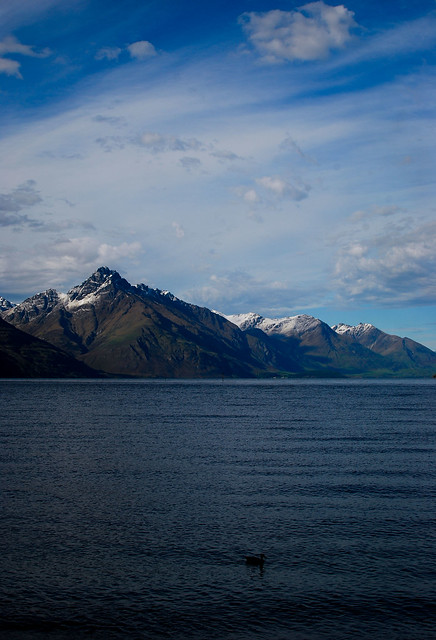
Waking up to Queenstown's Lake Wakatipu on a sunny morning was one of the best moments I had this year. What's more when the air was cool and crisp. A light breakfast later, I began my scenic drive to Fox Glacier.

From Arrowtown, I trailed the winding, steep Crown Range Road (on a basic 1.3L automatic car, this proved to be a challenge) to reach the golden plains of Cardrona and later, the shimmering blue twin lakes of Wanaka and Hawea. For a few hours, I'd completely forgotten about the rain.
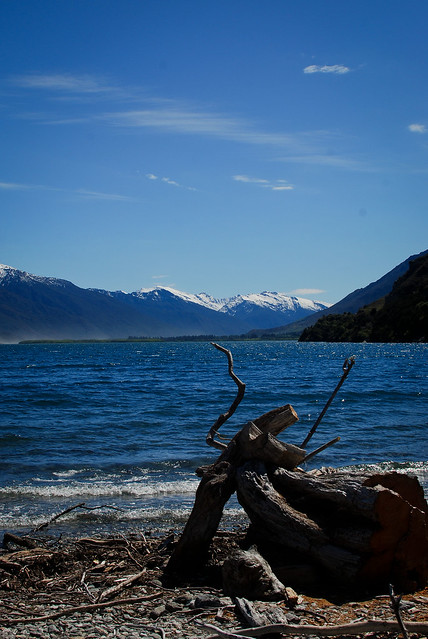
The sky rendered grey as I entered the village of Fox Glacier. The road turned misty, forcing me to slow down and turn on the windscreen wipers. Soon, it began to drizzle.
It was my intention to reach in the late afternoon. With a few hours of sunlight to spare, I was able to make an excursion to Lake Matheson - where on a clear day, promises a mirage of Mount Cook and Mount Tasman. Not on that day, unfortunately. The light rain had washed out the reflection. Even if the rain had stopped, Mount Cook would still be blanketed by thick, low-hanging clouds. Clearly, it wasn't my day. I was disappointed and solaced in the car munching a large bag of salt and vinegar potato chips.
The rain got heavier later that night. And my glacier walk was just a few hours away. I was terribly worried that the walk would be cancelled.
In the morning, the sky was bright again. Excellent, excellent! I took a look at my watch. It was 9:07 am. My walk would begin in 3 minutes! There was no time for a bath or brushing my teeth. I scrambled to wear my pants, put on my jacket and dashed for the door. I'd even forgotten about my passport and daypack. As I ran, I took a look at my watch again.
This time, the watch showed 7:00 am. I still had on my thermal pants and jacket. Outside, it was raining. I was obviously dreaming but I couldn't figure out which part of it was a dream. More importantly, in reality, the rain got heavier and there was no sign of it stopping in the next 2 hours. I envisioned a large WALK CANCELLED notice hanging outside the guide station. It wasn't about the money gone wasted that got me upset but the thought of having travelled thousands of miles to get here to fulfill one of my life dreams; just to be ruined by the rain.
There was no more optimism left in me. I dragged myself to the station, in the rain, for reporting. The station (which also functions as a souvenir shop and cafe) was warm and crowded. Before I could approach the receptionist, a staff instructed the full-day walkers to proceed to the left side for check-in. Yes, that's me! The walk would proceed despite the rain! I can't really describe how happy that announcement had made me.

Because it was raining, we were provided with raincoats and more serious-looking crampons. There were about 20 full-day walkers that morning. Later, we were divided into two groups. I went with a Brazilian couple (they were on their second honeymoon), two Taiwanese girls (who wanted to skydive in Queenstown), and the newlyweds from America. Our main guide was Megan from Canada. She was accompanied by a more experienced guide, Jono from Tasmania. Besides giving Megan a masterclass in guiding, Jono was also tasked to pave new routes for the coming walks.
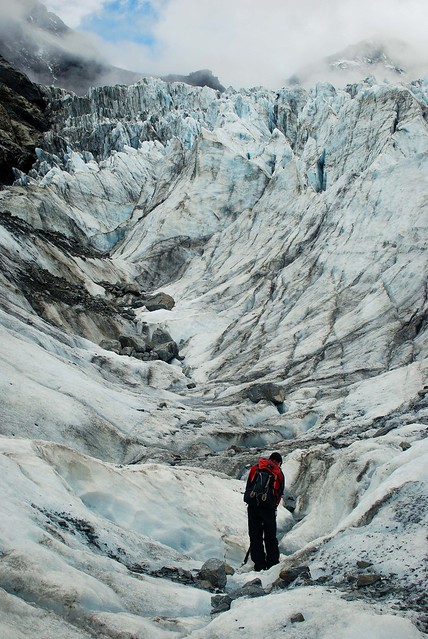
They have a name for the full-day walk. It’s called the Nimble Fox. Given the slippery surfaces, I guess we weren’t as nimble as we would have wanted to. Slowly, we ascended the glacier in the heavy rain.
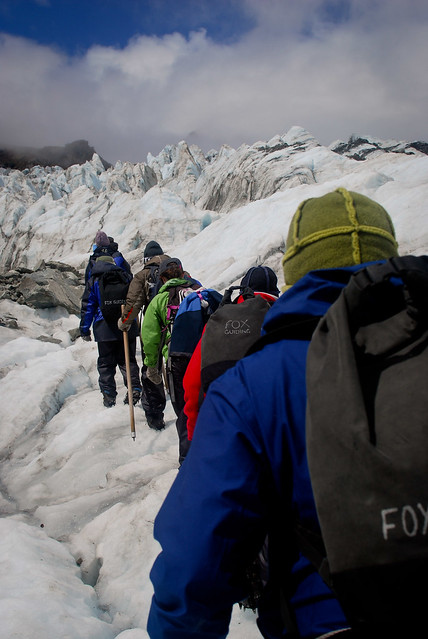
The science of the formation of glaciers is not difficult to understand but the visual effects that these compacted snows create are often magical. And they are always embellished with a spectrum of blue hues. Glaciers only appear blue because of the colour’s short wavelength, which can be reflected faster and not absorbed, as with colours of longer wavelengths; like red or green. To experience and understand better the science of this rare, natural phenomenon are the reasons that made me come to Fox Glacier.
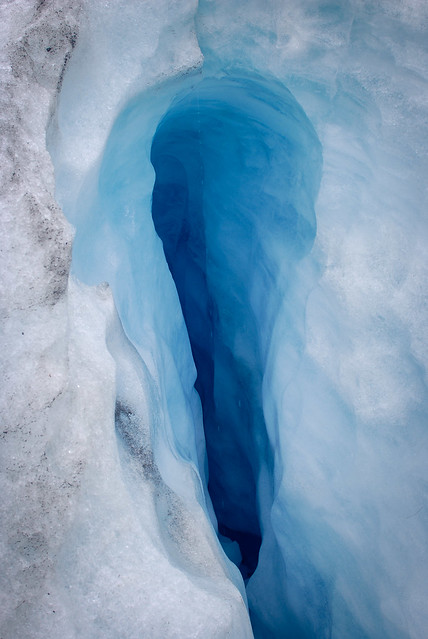

The course was not easy to complete. And if unguided, proves to be extremely dangerous. Megan and Jono did most of the hard work; axing the ice to sculpt flights of stairs to make our climb easier and safer. It’s also important to be aware of the crevasses. One slip is all it takes to have one fall into the bottomless depth. And it’s easy to forget about safety, especially one is distracted by the beautiful ice pinnacles and seracs. That’s why we walked in a line, so that we can look out for each other.
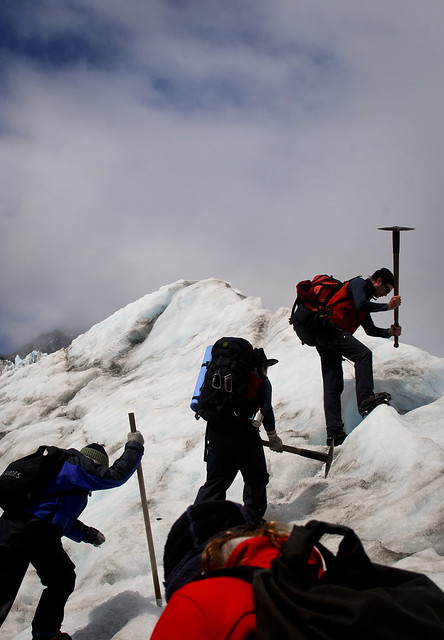
We found a good spot for lunch and obviously hungry, I chomped my Jimmy’s meat pie fast. Apparently, Jimmy’s is one of the most well-known pies in New Zealand. And it was tasty, with the gravy mixed with a good amount of cheese. I only realized that the rain had stopped when the strong reflection of sunlight on the ice pained my eyes. I told Megan that I’d expected the walk to be cancelled due to the rain. She explained that in the case of showers like this, walks usually proceed. I’d continued to say how worried I was about the weather throughout the trip. Sometimes, we just got to have some faith, Jono interjected, while peeling his orange.

The glacier terrain is dynamic. It moves a considerable distance daily and therefore, there’s never an exactly same route, only similar. And that day, we were lucky. As we made our way to the highest point of our walk, Jono found a new path that led us down a fresh crevasse of perhaps just three meters deep. To reach this spot, we had to climb over another pinnacle, at an almost right-angled slope. We left our daypacks behind (to reduce weight) and began the climb; one at a time.
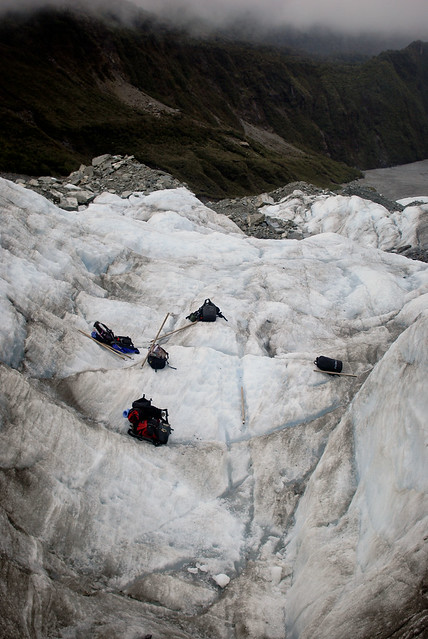
The view of the newly cracked glacier was amazing. We were allowed to land ourselves at the bottom of the crevasse to take some photos. Surrounded by the blue walls, I imagined myself walking on a frozen seabed. The few minutes spent down there were priceless. So was the taste of pure water dripping off the melting glacier.

Towards the end of our journey, the sky was grey again. And it started to drizzle when we neared the shuttle bus station. It’d been such an eventful day; from the dream to the rain to the spectacular glaciers to the newfound friends. Now, I felt that my Aotearoa journey had finally begun. I was looking forward to my next adventure. Was I still worried about the weather? Sometimes, we just got to have some faith. Sometimes, we just got to have some faith.
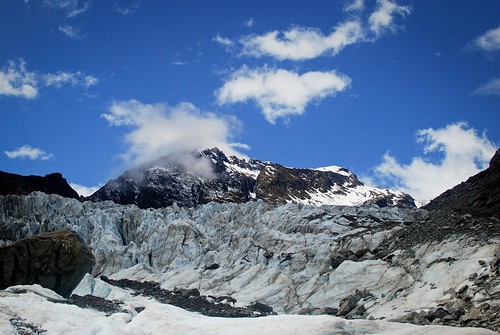










Fantasy adventures, be it in form of books or movies, do not interest me much. I did watch Peter Jackson's The Lord of the Rings trilogy though, but for the special effects and hype. After my visit to New Zealand, I wanted to watch them again, not because I have a newfound love for fantasies but just to be awed once more by the spellbinding, surreal sceneries. For me, it's not easy to describe the natural beauty that is New Zealand, so I thought I should begin my journey with a selection of photos taken as I made my way across this magical land; the home of Middle Earth.

NZ 647
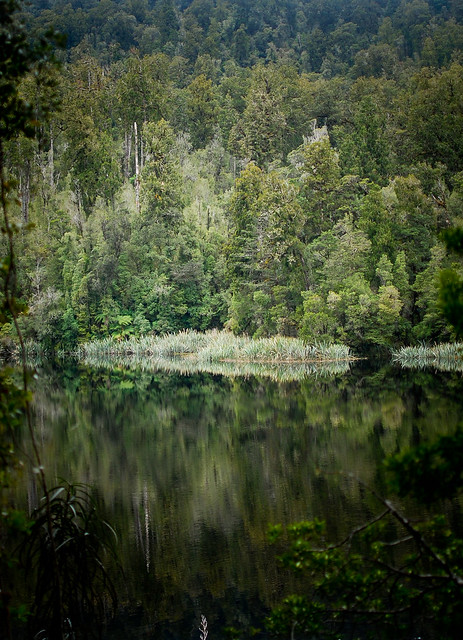
Lake Matheson, Fox Glacier

Fox Glacier
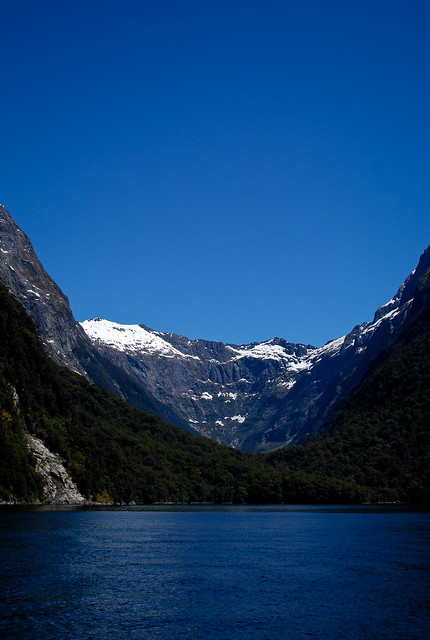
Milford Sound
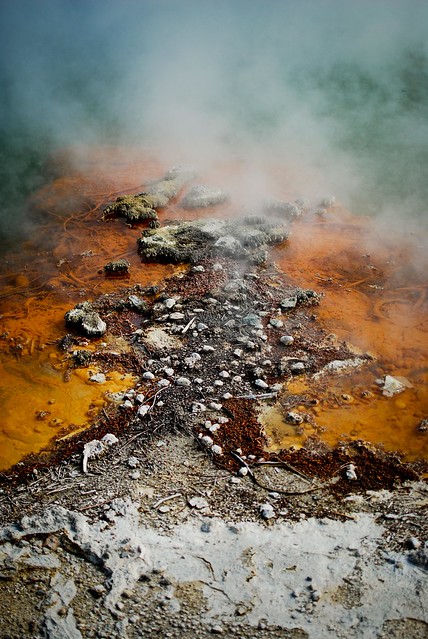
Wai-O-Tapu, Rotorua

Waimangu, Rotorua










Fukuharu
24 Nov 2011 5:27 AM (13 years ago)
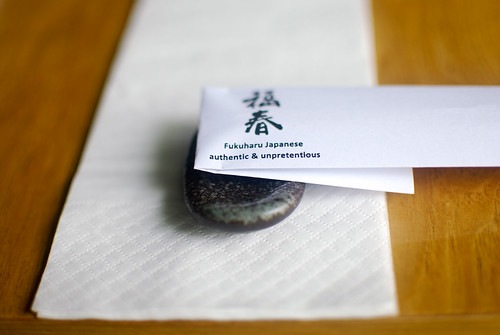
A worthy, value-for-money Japanese set lunch. The last time I was impressed by such a deal was back in 2008, when Lyrical Lemongrass, FatBoyBakes and I met for an eight-course kaiseki lunch at Fukuya, Bangsar One. I did find out later that Fukuharu also belongs to the owner(s) of Fukuya. That explains the similar minimalist interior, warm hospitality and affordable, homey Japanese food.
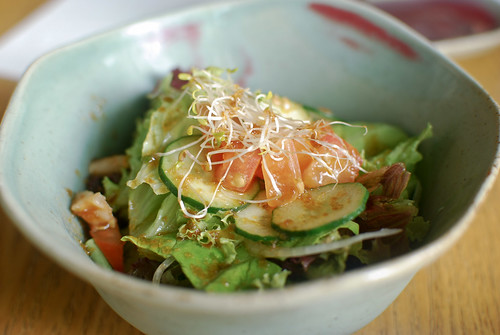
If not for FBB's dive wife (she's an admirable runner too), who'd highly recommended the set lunch, I wouldn't have travelled the distance to come to the TERRACE, given how horrendous the traffic can be like along Jalan Ampang. But more importantly, I wanted to catch up with her and share my recent running experiences.
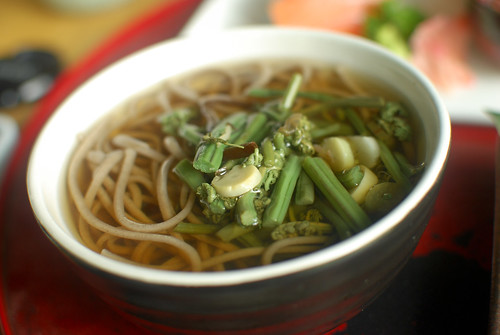
After a run earlier in the morning, I was certain that one set lunch (Japanese, especially) wouldn't be enough for me. But I was assured that the portions here are huge. The dishes rolled out one after another, starting with the salad, chawan mushi, choice of main dish (I chose the saba shioyaki, or grilled mackerel sprinkled with salt) and a bowl of hot soba (one can choose rice instead). The selection was J-typical but the ingredients remained fresh. Especially at only RM38+, there was nothing left to complain about, really. But of course, the stomach was only half filled, at best. But that's not their fault.
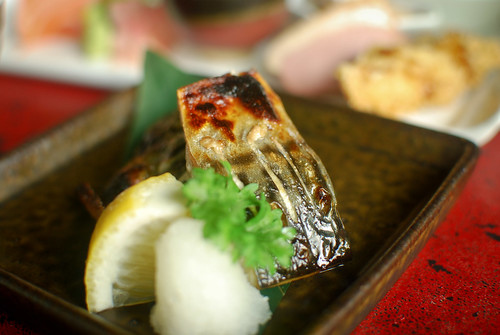
Somewhere between deploring the erratic slopes along the Putrajaya Night Marathon route and planning for the insane Western State 100 Mile Endurance Run (it will not materialise, believe me), we were served the mini kaiseki appetizer platter, which I'd absolutely forgotten. It was surprisingly a plateful. And of relatively good quality too. Among others, the salmon sashimi slices (and cubes - with a wafu-style dressing and served in a shot glass) were considerably fresh, the riceball-coated deep-fried prawn came à la minute crispy and there was even a cut of well-seasoned roast duck. Now that's what I call worthy.
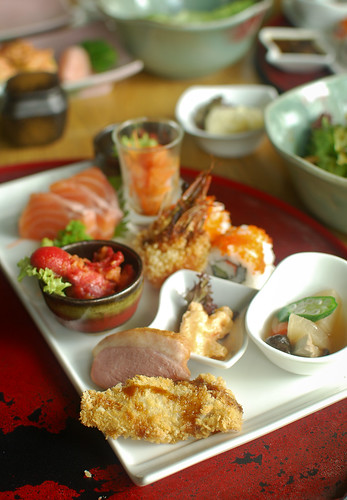
Our fervent discussion on running went on for some time (covering Asics/Saucony shoes versus the world, introversion of runners, strategic locations to hide hydration bottles while running, etc), paused only for dessert (part of the set). It was a simple, flavourful scoop of vanilla ice cream, interestingly drizzled with black sesame sauce.

Fukuharu brought back good memories of Fukuya at Bangsar One. Both restaurants offer unbeatable set lunches in a relaxed setting. Personally, I think that this is a better option for a weekend gathering of few friends than to splurge on a chic restaurant where just the appetizer of colourful foams and a deconstructed iced lemon tea cost more this set lunch.
Fukuharu
TERRACE at Hock Choon
241-B, Lorong Nibong off Jalan Ampang
50450 Kuala Lumpur, Malaysia










Yut Kee, finally.
16 Nov 2011 7:05 AM (13 years ago)
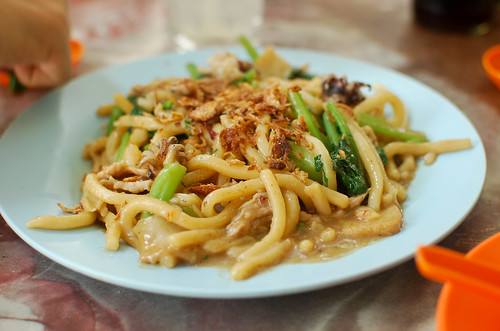
Dad said that he used to despatch chicken to Yut Kee from his employer's stall in the old Central Market. He would get a free meal every time he's there. People were more sincerely generous in the old days, weren't they? According to dad, the pork chop and egg roll were really good. All these years, he had never mentioned about Yut Kee (and I never asked why), until I suggested that we have lunch there a month ago. I took the family to Yut Kee a week after my first visit with a couple of friends. Having learnt that the best time to avoid is around the lunch hours, we took a slow ride to reach at 2 pm. Surprisingly, the famous pork belly roll was still available. What luck!

It's a very typical coffee shop but while many would see a more slowed and relaxed tea time, Yut Kee was still very much a high speed production line, churning out dish after dish. Despite the overflowing crowd waiting at the shop's front, I thought they operated efficiently; from allocation of seats to taking orders to the payment process. This system (which seems intuitive but nonetheless requires sufficient manpower and good coordination to work) that they've adopted shortens the waiting time significantly and puts the customers at ease. It's a major plus, really. I can't remember how many times I'd sworn that I'd be damned if I had to revisit some badly managed but prideful eateries in town.
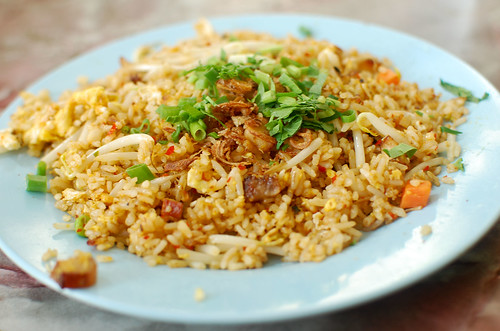
As we sat down, Dad began observing the surrounding, obviously looking for familiar faces but couldn't recognize anyone. He said the workforce had been replaced by, perhaps the next generation. There were four of us at the table, with eight dishes to share; including the westernized roast pork belly, which I thought was very good. It's all in bite - the crispy crackling, the aroma of lard melt bursting in the mouth and a nutty taste of the filling. The apple sauce gave an interesting sweetness to the salty meat. Of course, when one's at Yut Kee for the first time, one has to try the perennial favourites such as roti babi, Hailam mee and belacan fried rice. I didn't think much of the roti babi filling (which could do with more filling and seasoning) but the soft, encapsulating bread coated with a thin layer of egg was nice. I thought the roti was skillfully prepared. The taste is to be enhanced with a dip of the Worcestershire sauce.

On this second visit, I'd decided to try other less popular dishes on the board. Less because they were not seen on every table, unlike the roti babi and pork chop. I'd ordered the beef noodles served with a generous amount of meat and tripe, soft radish and a clear stock, and the Cantonese-style fried noodles with enough wok hei to keep me intoxicated and happy.
Let's talk a bit about the all-time favourite pork chop. The first bite unravelled a well-marinated piece of tenderized pork. The construction was traditional. From my (limited) pork chop experiences, the brown sauce is usually mild, bordering tasteless, even. That's not the case at Yut Kee though. The caramelized gravy was rich and flavourful, and went really well with the otherwise bland potato wedges and assorted boiled vegetables. Oh, not to forget a sprinkling of the appetizing Worcestershire sauce too. However, Dad did mention that the pork used to be crispier, but perhaps due to higher demand, were pre-cooked, hence the softness.
Growing up, I was privileged enough to have eaten quite a fair amount of Hainanese noodles cooked by an aunt of mine. It's quiet different from my usual Cantonese and Hokkien mee with the noodles simmered over a longer duration and served soupy but less starchy than loh mee. Yut Kee's Hailam mee was different. The soup was reduced to an almost stir-fried consistency. Still, it was a tasty treat, especially when eaten with the topping of some fragrant, crunchy fried shallots.
The extensive menu at Yut Kee is posted on a larger than life whiteboard hung on the sidewall. So far, I've only tried a small fraction of it. For me, every visit is to try something new, and to discover something old but gold as well. Here, especially when dining alone or in a small group, chances are that one would be sharing a table with older loyal customers that are happy to share their tales of Yut Kee or recommend some dishes. Tourists also flock this coffee shop, which I think is a good choice. It's definitely a more identifiable Malaysian experience. Truly Asia what?
I didn't ask Dad what he thought of today's Yut Kee. He seemed pleased though, whopping one dish after another. Perhaps for him, there was a taste of nostalgia in the food too.
Take away the hype, the rustic interior (which is one of the attractions of this coffee shop) and endless free publicity, I will still be back at Yut Kee, simply because the food is good and affordable (especially in this part of the city). Not many good old coffee shops like this survive the test of time so I really hope that they'll stay for long time. And I'm confident of that, unless of course, there's a forced, unwise plan to demolish this row of shophouses in the name of development.
Yut Kee
35, Jalan Dang Wangi
Kuala Lumpur, Malaysia










...or hairy crabs, as they are usually known as.
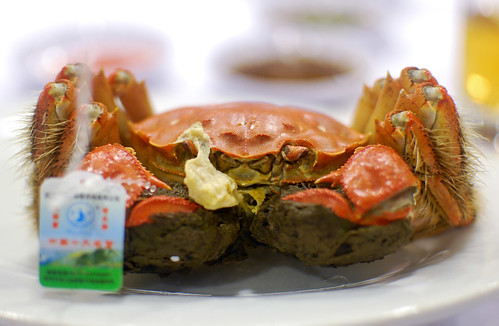
I knew I'd be late, given the rush hour madness at the MRT stations. The heavy wooden toy set (it must have been at least 6 kg) that I'd lugged all the way from Paragon wasn't very helpful in increasing my pace. So I decided to take the good old bus to get to Capital Restaurant instead. Not a bad idea. In fact, it was brilliant. Not only was the bus relatively spacious (as compared to the over-packed trains), the ride was also smooth and fast. I reached much earlier than expected and could afford to withdraw some cash, try a bowl of fishball (the stall called it fish bakso) noodles from the People's Park food center and identify some of the most competitive money changers in the adjacent complex. It was a very good start to the dinner ahead.
The name Capital (首都) itself has already given an impression that it's been around for decades. New restaurants don't bank on names like this. They prefer something, anything that catches your attention or raises an eyebrow. I'm sure one who's reading this can instantly name a few. Well, I happen to think that there's a certain rustic charm to a name like Capital. And to have survived so long in this dynamic F&B business on this little red dot means something.
This is at the fringe of Chinatown, an area that I'd only passed by, but never took notice of the shoplots. If not for wanting to try hairy crabs, I wouldn't have known the existence of Capital. Some hotels in town offer hairy crabs too, but I don't think the prices are as affordable as here.
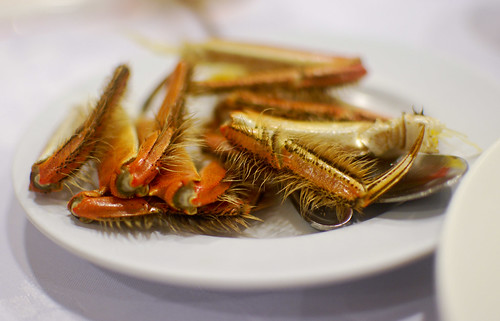
What's the correct procedure to dissect the crab to fully savour its taste? Do we taste the fur on the claws? Is there a particular sequence to eating the legs, claws or roe first? I came absolutely unprepared and tried to do some last-minute research online but the mobile broadband service was down. So many burning questions unanswered! The shameless stomach was growling. I had to get started. It was me, a pick and a pair of scissors against steamed hairy crab number XXXXXXXXX from the Tai Lake in China. I strategized by digging the remains of my secondary school biology knowledge and mostly logic.
Firstly, I cut the hairy legs. Followed by the mitten claws. Now, I was left with the body. Gosh, this sounds like Natsuo Kirino's Out already! I separated the shells by gripping the upper half and pulled the lower half. It was easier this way as there was a dent on the lower half that could fit the tip of my index finger. With one gentle pull followed by a crack, a molten, golden mass of roe was revealed.
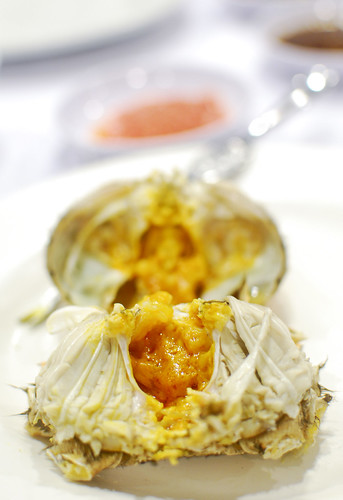
We, the hairy crab virgins, decided that the roe was as rich as a salted egg yolk. I even suggested that it's a crustacean version of the steamed salted egg bun. The flesh was sweet, subtly. The dip of ginger and black vinegar provided a refreshing contrast. A small Chinese cup of ginger tea was served after we were done with the crabs. The Chinese believe that ginger will dissipate the wind accumulated from consuming the cooling hairy crabs. It was one fiery cup of tea, for sure. On average, it took us about 30 minutes to devour the fist-sized crab, which weighed about 200 g, if I recall correctly. The neighbouring table sat a couple attempting 3 (or 4) crabs each. I wonder how long it took them to finish all the crabs.
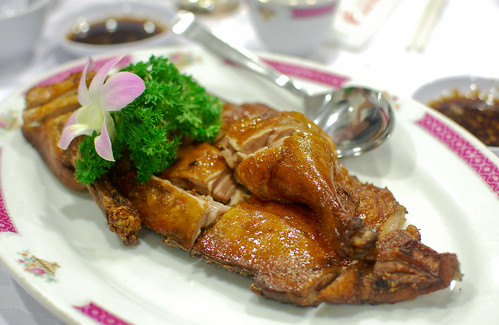
I think we made the right choice of having the crabs as our first dish. Some prefer to have it last. I'm sure, if served last, we would have been full and less enthusiastic about spending 30 minutes digging for crab meat and roe. And inevitably, some precious parts would have been ignored and wasted.
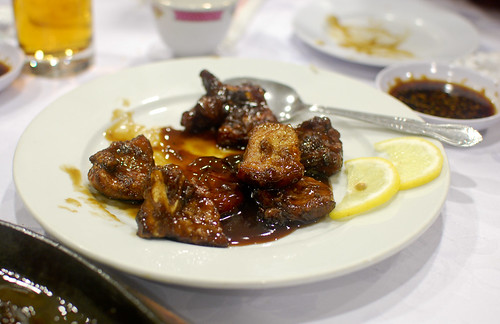
The rest of the recommended dishes were mostly Cantonese fare. My favourite was the roast duck, which must have been showered with boiling oil, post-roasting, for that extra crisp on the skin. Coupled with well-seasoned and succulent meat, I thought it was fantastic. I wouldn't say that pork cutlets in coffee sauce, sizzling venison with scallion and spinach soup with 3 types of eggs are representative of classic dishes served at Capital but they were still delicious. Perhaps the captain thought that young people like us (how much more shameless can I get?) would prefer more familiar, modern dishes.
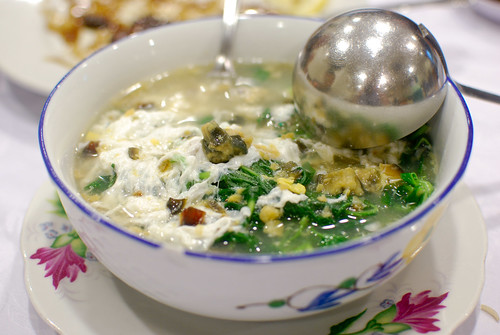
With a full and now, quiet stomach, I left Capital with the 6 kg toy set still in tow. I didn't mention earlier that the toy was purchased for work purpose and unrelated to the dinner. I just had to bring it along since I was already in town. The next morning, I carried it through a 500 m walk, 1 MRT and bus ride each before reaching the office. Along the way, I'd also reminisced about the golden roe and roast duck. And that really made the journey less exhausting. You may call me cheesy now.
Capital Restaurant
323 New Bridge Road
Singapore 088759











 Finishing the Macau Marathon with a new personal record was sweet. But more significantly, the race marked the completion of my 10th full marathon, a goal I'd set for myself in 2012. Throughout the year, I'd tried to train as consistently as I could (even if it involved sacrificing my social life) and read a few books on running to keep myself psyched up. In the process, besides improving my runs, I'd learned quite a bit about life. Running has made me more patient, tolerant and respectful of others. Physically, I'm fitter and although mortality is still out of my control, keeping up with a healthier lifestyle by eating well and working out regularly has led to less flu and common cold. What a good run, 2012!
Finishing the Macau Marathon with a new personal record was sweet. But more significantly, the race marked the completion of my 10th full marathon, a goal I'd set for myself in 2012. Throughout the year, I'd tried to train as consistently as I could (even if it involved sacrificing my social life) and read a few books on running to keep myself psyched up. In the process, besides improving my runs, I'd learned quite a bit about life. Running has made me more patient, tolerant and respectful of others. Physically, I'm fitter and although mortality is still out of my control, keeping up with a healthier lifestyle by eating well and working out regularly has led to less flu and common cold. What a good run, 2012!




 Soon after the race, the Pasar Besar Seremban foodcourt was filled with runners, most of them wearing finishers’ tees, especially the 2012 edition of the KL marathon. This busy pasar was quite the obvious choice for runners to refuel after their run because here’s where some of the most famous Seremban hawker stalls are located. While waiting for the legendary beef noodles to be served, I had, firstly, a plate of cuttlefish beehoon that came piping hot and full of wok hei. It was very satisfying. Next, still waiting for the beef noodles, I had Tow Kee’s Hakka mee, which despite its visual modesty, was a toss of well-proportioned egg noodles, minced pork and lard that resulted in a wonderful taste that I believe, can only be achieved through years of experience. The beef noodles finally came...30 minutes later. The gravy wasn’t as sweet and sticky as I’d remembered almost a decade ago. Bordering starchy and almost bland, it was a rather letdown.
Soon after the race, the Pasar Besar Seremban foodcourt was filled with runners, most of them wearing finishers’ tees, especially the 2012 edition of the KL marathon. This busy pasar was quite the obvious choice for runners to refuel after their run because here’s where some of the most famous Seremban hawker stalls are located. While waiting for the legendary beef noodles to be served, I had, firstly, a plate of cuttlefish beehoon that came piping hot and full of wok hei. It was very satisfying. Next, still waiting for the beef noodles, I had Tow Kee’s Hakka mee, which despite its visual modesty, was a toss of well-proportioned egg noodles, minced pork and lard that resulted in a wonderful taste that I believe, can only be achieved through years of experience. The beef noodles finally came...30 minutes later. The gravy wasn’t as sweet and sticky as I’d remembered almost a decade ago. Bordering starchy and almost bland, it was a rather letdown.





















































































